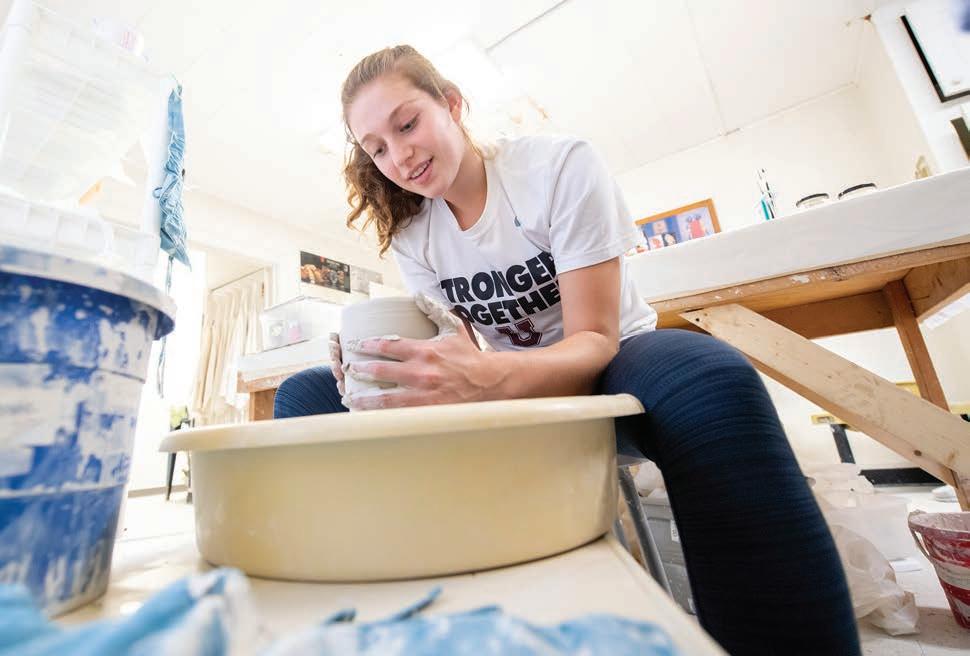UNIONCOLLEGE



ALSO INSIDE: Endowing a legacy of learning






ALSO INSIDE: Endowing a legacy of learning


ON THE FRONT COVER "Umbrella" by Henry Jones '21. Read his artist's statement on p. 1.
VICE PRESIDENT FOR COMMUNICATIONS AND MARKETING
Mark Land
EDITOR
Erin DeMuth Judd demuthje@union.edu
CONTRIBUTING WRITERS
Charlie Casey
Christen Gowan
Tina Lincer
Phillip Wajda
CONTRIBUTING
PHOTOGRAPHERS
Paul Buckowski
Shawn LaChapelle
DESIGN
2k Design
PRINTING
Fort Orange Press
UNION COLLEGE is published three times a year by the Union College Office of Communications, Schenectady, N.Y. 12308. The telephone is (518) 388-6131. Non-profit flat rate postage is paid at Schenectady, N.Y., and an additional mailing office.

Postmaster: Send address changes to Office of Communications, Union College, Schenectady, N.Y. 12308-3169.
Alumni who want to inform the College about changes of address should contact the Alumni Office at (518) 388-6168 or via e-mail at alumni@union. edu. The same phone number and e-mail address should be used to correspond about ReUnion, Homecoming, alumni club events, and other activities.
“Layers of Autumn,” an exhibition showcasing student art painted in outdoor settings around the Capital Region, opened at the Kelly Adirondack Center in January and runs through June 4. The show features works by students who were part of the fall Plein Air Painting course. Read more at union.edu/ news/plein-air
Alumni thrive in the art world, a place where all manner of fields, businesses, people and ideas intersect. Their stories reflect the essence of Union—a community that embraces and appreciates the interconnectedness of art and other disciplines.
Donald R. Thurston, professor emeritus of Asian Studies, spent his teaching career helping students fall in love with Asia just as he did seven decades ago. With the establishment of an endowed professorship, he aims to continue that legacy for generations to come.

Henry Jones ’21 explains his work, which graces the cover of this issue. Based in Palo Alto, Calif., he is a front-end web developer for Mushroom.gg.
Umbrella was an endeavor to explore global illumination and refraction as I dove deeper into the world of 3D during my junior year. After learning a few techniques for generating convincing water droplets and splashes without simulation, I decided to use this as my first foray into illuminating a scene with a single HDRI image, which lent depth to the piece by giving each droplet and splash its own unique refraction. Since graduating, I transitioned away from Cinema4D over to Blender, where I continue to create static works. However, I've found much more satisfaction in combining my passion for 3D art with my professional knowledge as a computer scientist to create interactive 3D web art using Three.js, a JavaScript package for 3D artists.
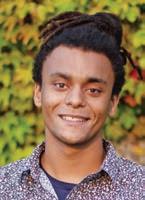
The cover story of this magazine focuses on art at the intersections. As several of the articles that follow make clear, innovations often arise at intersections. It is the courageous creativity of our community, and the ways in which we challenge and support one another to go beyond our comfort zones, that so often enables us to achieve more than we may have thought possible. It is what accounts for Union being a place that gives rise to so many inspiring stories of transformation—in the arts, in business, in not-for-profits, in technology, and in so many other domains.
In this column, I’d like to focus on two prominent and inspiring intersections that have recently been featured at Union. The first is the intersection of Black History Month and ice hockey. The second is the intersection of disciplines reflected in an art installation, during Women’s History Month, about women who have transformed their fields and the world.
Some may have thought it a little strange that in the middle of February, Black History Month, we held a webinar discussion on the state of ice hockey.
True, hockey is not exactly the first thing that comes to mind as we celebrate the contributions of African Americans on campus and beyond.
But that’s exactly why we did it. Eliminating the barriers that block the intersection of hockey and the African American community can only create opportunities for more people and make the game stronger.
Last summer, Union hired two outstanding assistant coaches—Lennie Childs and Olivia Soares—who have had a tremendous impact on their players and the game. They also happen to be two of only a few African American coaches in all of college hockey.
I thought it was important to hear their stories and to bring others into a conversation about how kids today have unprecedented opportunities to participate in this sport. And how we can continue to grow the game.
We were joined by Guy Logan ’90, a former captain and assistant coach at Union and now an investment banker and Union trustee; Meredith Lang, founder of Mosaic Hockey Collective, a Minnesota-based BIPOC hockey program for boys and girls; and Jeff Scott, vice president for community development and growth for the National Hockey League.
Change is coming. Lennie Childs, who spends considerable time recruiting, observes, “There’s more color on the ice at the youth hockey levels than I’ve seen before.”
What was clear in our discussion was that growing the game requires something beyond simply providing
access. It requires committed and caring mentors.
All of the participants related stories about the challenges and opportunities of being what Jeff Scott termed “the only.” They also related experiences in which someone—a role model, a teammate, a coach or teacher—reached out to make a connection. When that someone is also African American, it means even more. “When you could connect with someone that happens to look like you in the game that you love, it could be transcendent,” Logan said.
You can watch the webinar at union.edu/hockeydiversity.
When we celebrated Women’s History Month in March, we asked students, faculty and staff across campus to reflect on the many women who throughout history have had a transformational impact in their discipline.
Union answered the call with hundreds of posters that adorned the Women’s History Wall in the hallway between Wold and ISEC.
Astronaut Sally Ride, who in a male-dominated field was the first woman in space. Henrietta Lacks, whose DNA (taken without consent or credit) has transformed medical research. Frances Perkins, a workers rights activist who served as secretary of labor with FDR and was the first woman to serve in a presidential cabinet. These are a few of the women profiled in the Women’s History Month Wall Project.
You can learn more at union.edu/womens-wall.
One of the goals was to honor and celebrate these women for their achievements, according to organizer Anouk Verheyden, senior lecturer in geosciences.
Another, and perhaps more important, goal was to reflect on the fact that while women have made great strides toward equality, they are still facing challenges, particularly in the workplace. These include a gender pay gap, bias, discrimination and sometimes, aggression. For women of underrepresented groups, the hurdles are even higher.
This project, like our discussion about expanding hockey to underrepresented communities, required us to leave our comfort zone and to have sometimes difficult conversations about the work that remains.
Union’s broad range of disciplines, and the intersections between them, makes our campus an ideal place to have conversations toward finding innovative solutions to complex challenges.
But it’s the courage and creativity of members of the Union community—students, faculty, staff and alumni— that will have a transformative impact in addressing these challenges.
 DAVID R. HARRIS, P h .D.
DAVID R. HARRIS, P h .D.
In reading the memoriam for Bill Russell, that day was brought home to me once again.
It was very cold and I was wearing no socks. So, my mother, not wanting me to receive my degree under-dressed, had my brother give me his socks. I forgot all about that when Professor Carl Niemeyer (about 5’8”) went to put the honor around Mr. Russell’s neck. Prof. Niemeyer stretched his arms up and only got as far as Mr. Russell’s nose. There was dead silence while Mr. Russell stood straight, at attention, looking down at Prof. Niemeyer, who had a rather shocked look on his face. Then the corner of Mr. Russell’s mouth twitched, he broke into a broad grin, and as everyone laughed and applauded, he graciously bent over so Prof. Niemeyer, now with a broad grin, could complete his task.
Later in the ceremony, as the degrees were handed out, Mr. Russell was sitting on a chair to the side of the dais.
I must have had a relieved look on my face as I was handed my degree, because Mr. Russell, as I approached, quietly said, “Was it really that close?” I still remember my reply, “Mr. Russell, you have no idea!!” I exited to the sound of his belly laugh, and nobody else knew why. His warmth and empathy expressed in that moment and those few words have stayed with me throughout my life.
DANIEL D. DASHMAN ’72Ifirst met Professor Kaminsky during freshman preceptorial, winter term, 1984. That’s a nineteen-year-old me wearing the down vest, to the right of Professor Kaminsky in the picture.
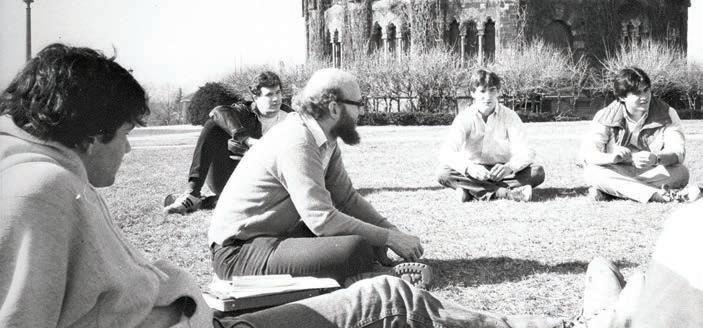
Simply put, Stanley Kaminsky ’75 was extraordinary.
To date, he remains one of the finest educators, advisors, friends and human beings that I have ever known.
During preceptorial, Professor Kaminsky taught me many things. He taught me how to write and to read critically. But most importantly, he taught me how to discuss. I learned that perspectives vary, and that even the meekest among us have a story to tell. Most importantly, he taught me how to listen to that story—the stuff of revelation was often found within.
At his suggestion, I took his class, “Philosophical Problems,” the following trimester. On the last day of that class, a
student asked him, “Professor Kaminsky, 10 years from now, what am I supposed to remember from this class? What exactly has philosophy taught me?”
Professor Kaminsky thought a moment and responded with an answer I will never forget.
“Your mind is a tree and hanging on that tree are all the ideas you ever held onto firmly. Philosophy is the wind that shakes that tree so firmly that some of those ideas drop, and those that remain are never as firmly attached as they were.”
I added philosophy to my major the next day—one of the best decisions of my life.
Thank you, Stanley. You were loved, and you are missed.
JOSEPH P DAMORE JR. ’87, M.D. Editor’s Note: Professor Kaminskyis further remembered on p.
72.During Founders Day Feb. 23, the campus community gathered in Memorial Chapel to celebrate the 228th anniversary of the granting of Union’s charter.
To watch video highlights from Founders Day 2023, visit facebook.com/unioncollege

Andrea Barrett ’74, a National Book Award winner for fiction for “Ship Fever and Other Stories,” began her keynote address by honoring “the beautiful retreat we know as Jackson’s Garden,” one of her earliest pleasures of campus life.
She credited the College for nurturing in her something that Tolstoy called “the blinkered energy that sends us exploring down paths that often lead nowhere but which, just occasionally, result in useful discoveries.
“Only a willingness to explore paths on which we might fail lets us unfold into the people we can be,” Barrett said. “Walking along the paths of Jackson’s Garden, you can marvel at all the revisions that, over
almost two centuries, have generated such a complex and lovely space.
“Lives, like gardens and stories, shift and swerve unexpectedly if we let them—and that’s a good thing. Nothing’s more useful than the courage to keep revising the way we should live, who we should be, what we can best bring to the world.”
Barrett has written five other books,
including “Servants of the Map,” a finalist for the 2003 Pulitzer Prize in Fiction. She also has received a Guggenheim Fellowship and a MacArthur Fellowship, or genius grant, which carries a prize of $500,000.
She majored in biology at Union and lives in New York’s Champlain Valley with her husband, Barry Goldstein ’73.
Following her talk, President David R.
Harris presented Barrett with the Eliphalet Nott Medal, which recognizes the perseverance of alumni who have attained great distinction in their fields. The medal is named for Eliphalet Nott, president of the College from 1804 to 1866.



Also at Founders Day, Sarah Christy, a music teacher and choir director at Averill Park (N.Y.) High School, received the Gideon Hawley Teacher Recognition Award, which honors a high school teacher who has had a continuing influence on a Union student. Francesca Morone ’26 nominated Christy.
The celebration opened with remarks from Kathleen LoGiudice, College marshal and professor of biological sciences; Robert Bertagna ’85, chair of the Board of Trustees; Stephen Schmidt, chair of the Faculty Executive Committee and Kenneth B. Sharpe Professor of Economics; and Gwyneth Sultan ’23, president of Student Forum. The ceremony concluded with a performance of “While These Visions Did Appear,” an original digital composition by Aspen Morris ’25, and a jazz-influenced rendition of “Ode to Old Union,” led by Tim Olsen, professor of music.
Andrea Barrett '74 delivers the keynote address.Union is a special place with a great story to tell. Telling that story consistently in ways that resonate with all members of our community—and also notably with prospective students and their families who represent the College’s future—is among the College’s strategic priorities.

As we look forward, the time is right for the Communications and Marketing organization to pursue a refresh of the Union brand. Initial “deliverables” for this work include:
• Updated messaging designed to crystallize Union’s distinctiveness and advantages relative to our peers and competitors
• A new branding platform that will refine and articulate our storytelling
style, design elements, the visual components of our work and more
• An exploration—and possible updating —of the current Union logo and word marks
• Possible creation of a marketing tagline for the College
• Exploration of Union’s nickname and mascot, and possible alternatives to “Dutchman/Dutchwomen” that may better represent the vision of Union today and what we aspire to be in the future. To learn more about the nickname search, visit union.edu/ communications/nickname
• Development of creative concepts to serve as the foundation for future communications and marketing campaigns
• Creation of brand guidelines to ensure consistent application of Union’s messaging and visual look and feel across the College
The College has contracted with the marketing and branding firm Truth & Consequences to serve as our partner in this process.
As this effort continues, there will be opportunities for all community members to share their ideas and viewpoints.
You can share your thoughts about the Union brand and/or tell us if you’d like to be included in future opportunities to provide feedback by contacting us at ucco@union.edu.
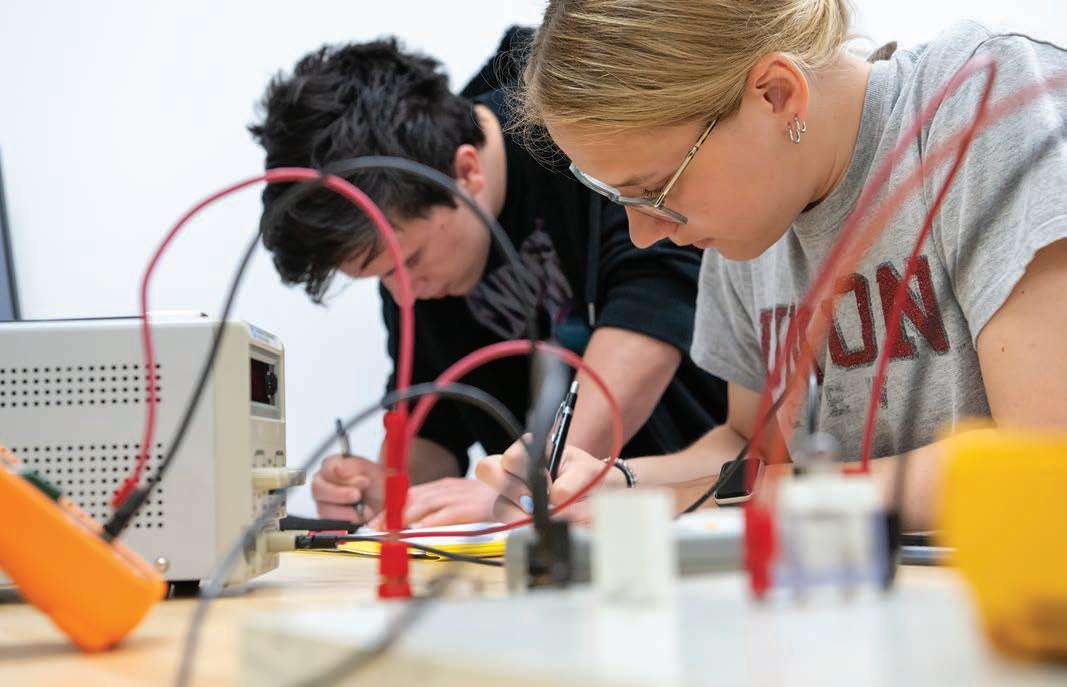
Union has been awarded a grant from the renowned Howard Hughes Medical Institute to strengthen the study and teaching of science, technology, engineering and math (STEM) for all of its students.
The HHMI Inclusive Excellence 3 (IE3) initiative challenges U.S. colleges and universities “to substantially and sustainably build their capacity for student belonging, especially for those who have been historically excluded from the sciences.”
A nonprofit focused on research and philanthropy to advance science and education, HHMI will contribute $505,000 over six years to support the College’s efforts.
IE3 is distinct from previous HHMI science education initiatives because it begins with a learning phase in which communities envision how to move cooperatively into an implementation phase.
During Union’s learning phase last winter, Jennifer Fredricks, dean of Academic Departments and Programs, and David Cotter, professor of sociology, interviewed dozens of students with different trajectories in STEM to collect feedback on how the College supports its students. The information was shared with STEM departments, which discussed ways the grant could support departmental goals.
For its next phase, Union is part of a cluster with 15 other institutions, which
will focus on specific areas. Among them is meaningful evaluation of effective and inclusive teaching, which will inform faculty practices, including promotion and tenure decisions.
“The transformational aspect of this grant is the mindset shift from ‘fixing the student’ to examining current structures, policies and curricular barriers that are getting in the way of student success, especially for historically underrepresented students in STEM,” said Nicole Theodosiou, associate professor of biological sciences and project director of the grant. “I am excited to have the unique opportunity to support transformational change so that every student at Union is empowered to succeed.”
9,400 applications for the Class of 2027
600 early action applications
50 states
138 countries
Nearly 9,400 prospective students—a record number—applied to join the Class of 2027. The total number of applications is an 11 percent jump from the year before.

The biggest surge came from those who chose the early action option. Nearly 600 more students applied through early action this year than a year ago, including many from outside the Northeast. Under early action, students have an opportunity to apply by Nov. 1. They are notified of their admissions status in late December and have until May 1 to accept an offer. Unlike early decision, early action is non-binding. If admitted, a student is not required to attend.
Overall, the number of applications rose in key demographic areas, including female students, first-gen students, traditionally underrepresented racial and ethnic groups, and international students.
The applicant pool represents all 50 states and several U.S. territories, along with 138 countries. The expected size of the Class of 2027 is 570 students.
Professor of Spanish Christine Henseler has created a new guidebook, Arts and Humanities: Don’t Leave College Without Them. The 350-page e-book is aimed at helping high school and college students think about the role that the arts and humanities can play in their lives and careers.
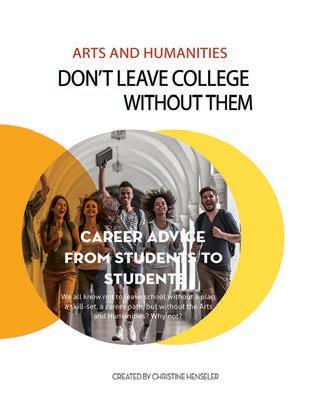

The book includes essays by students, alumni and young professionals, portraits of young innovators, information about majors, success stories, interviews and more.
As Henseler writes in the introduction, the book articulates “how the arts and humanities can play a foundational and transformational role in your lives and careers, whether you are thinking about
going into the art world, business, medicine, engineering, environmental science or any other profession.”
Nate Boule ’23, a biomedical engineering major from Plattsburgh, N.Y., wrote an essay on the impact of taking a humanities class.
“I’m not sure who I would be if I wasn’t required to take a course in humanities,” he wrote. “I could assume that I would be the same high school student who thought they had everything in their life and that their future would work out exactly the way I imagined. Humanities were the key that unlocked me from being trapped in this constant cycle of thought. They have provided me with valuable skills that I would not have developed otherwise.”
Check out the new guidebook, Arts and Humanities: Don’t Leave College Without Them, online at online.flippingbook.com/ view/980440814/
Christine Henseler, professor of Spanish and Hispanic Studies, teaches a class.The winningest coach in Union College history, Mary Ellen Burt has retired after 26 years leading women’s basketball and 11 years at the helm of the women’s golf program that she launched.


Her career as an athlete and coach has ridden the rising tide of women’s athletics. A standout high school basketball player from Webster, N.Y, near Rochester, she went to Division I University of Southern California.
In those early days of Title IX, she was among the first women to earn a full athletic scholarship. “To have a college coach offer a

full scholarship from little Webster, N.Y. to Southern Cal was pretty cool and you can’t say no to that,” she recalled.
When she decided to pursue coaching, she looked for Division III jobs to work with “the all-around kids,” not just those focused on basketball.
Before she joined Union, she held assistant coaching posts at the University of Rochester and Southwest Texas State University. She also worked in the admissions office at Rochester.
At Union, she has played a key role in expanding opportunities for women in athletics. She was part of the gender equity committee that made recommendations to expand athletic offerings for women. She has been a regular guest in classes to talk about the impact of Title IX on her career and women’s athletics nationally.
Burt finished her basketball coaching career in 2021 with 344 wins, the most for any Union coach, men’s or women’s. For the last two years, she has coached only women’s golf, a program that has broken the school single-season record for the fourth time in the last five seasons.
In a recent video available on the Union web site, Burt recalls a campus visit by broadcaster Robin Roberts, herself a standout college athlete. She talked about the impact of those who came before, saying, “They lowered the ladder so that others could climb.”
To watch the video, visit union.edu/ maryellen
Getting research from the lab to the marketplace is a challenge for researchers and students at any institution. At undergraduate institutions, the barriers are especially high.
In January Union hosted SUITED, a National Science Foundation-funded forum aimed at helping faculty and administrators from undergraduate institutions explore opportunities to develop technology in the U.S. (SUITED stands for Supporting Undergraduate Institutions in Technology and Entrepreneurship Development.)

Interest in the workshop, which included hybrid and virtual sessions, was high. Approximately 170 faculty and administrators from 30 states registered to participate. For details, visit union.edu/suited
“A lot of research is done by faculty and students at primarily undergraduate institutions, but it does not often lead to technology transfer and commercialization,” said Ann Anderson, the Agnes S. MacDonald Professor of Mechanical Engineering and conference chair. “There are tremendous opportunities for taking these great ideas and getting them out to the marketplace.”
Union, Olin College and CUNY are the only undergraduate institutions that have participated in NSF programs to investigate tech commercialization potential, she added. Union and Olin are the only ones to have a partnership in innovation grant from NSF to bridge basic research and commercial work.
Anderson, along with colleagues Mary Carroll ’86, the Dwane W. Crichton Professor of Chemistry, and Brad Bruno, professor of mechanical engineering, obtained NSF funding for the SUITED workshops, which are to include two other in-person conferences at Union later this year.
The faculty trio has experience in this area. They lead the College’s Aerogel Lab, which has received patents for the manufacture of the lightweight material that has a wide range of applications.
Anderson and Carroll have founded SunThru, a Schenectady startup that is commercializing silica aerogel inserts for energy-efficient windows. Two former students, John Costa ’17 and Adam Forti ’17, serve as CEO and COO, respectively.
At the opening session of the SUITED Workshop, from left, Jesús Soriano, program director of the National Science Foundation; Lisa Avila, CEO of Kitware, a software research and development company; President David R. Harris; and moderator Mary Carroll ’86, the Dwane W. Crichton Professor of ChemistryJennifer Mitchell ’04, assistant dean for diversity, equity and inclusion, has been named a NY6 Mellon Academic Leadership Fellow by the New York Six Liberal Arts Consortium.

An associate professor of English and of Gender, Sexuality and Women's Studies, Mitchell is among six faculty members in humanities and related fields selected from each of the NY6’s member institutions. In addition to Union, these include Colgate University, Hamilton College, Hobart and William Smith Colleges, St. Lawrence University and Skidmore College.
The two-year program is funded with a $1.5 million grant from the Andrew W. Mellon Foundation. Fellows will explore academic leadership through an immersive experience on their home campus, in
which they will gain deeper knowledge and understanding of higher education administration, while working on a discrete project or portfolio that will advance important goals of their institution.
Mitchell joined Union’s faculty in 2015 and was named assistant dean for diversity, equity and inclusion in November.
“The responsibilities that come with this position—working to recruit, retain and support diverse faculty, to ensure that our review processes are equitable and fair, and to help develop Union's commitment to inclusive pedagogy—are all very important to me,” Mitchell said. “I look forward to continuing and expanding this work with people all across campus in order to make Union a more welcoming, attentive and supportive community.”

Union’s Strategic Plan makes clear our intention to have every student, and every person on campus, be a part of this vibrant community of learning. A new report, titled “Every Student,” highlights some of the milestones that we have reached together over the past several years. As we celebrate our progress, we acknowledge that our work to create and maintain an inclusive and welcoming community is never done. And that it requires every one of us.
Read the report at union.edu/every-student
Kara Doyle was in the middle of a busy holiday season, with visiting parents and a half-finished kitchen remodel.
So she could be forgiven for dismissing an email from “Elvis Costello” as another version of the Nigerian prince scam or a prank by a friend.
But the second email, this one signed by Declan McManus (Costello’s birth name), sparked her curiosity.
When she responded, it was the Elvis Costello, the multi-Grammy-winning member of the Rock and Roll Hall of Fame. He was assembling a group to back songs during a concert, and had found Doyle’s website.
The professor of English, Chaucer specialist and Dean of Academic Departments and Programs also happens to be an accomplished player and teacher of uilleann pipes, a mainstay of Irish music.
On Feb. 10, less than two months after that email exchange, Doyle was one of five musicians backing Costello for a sold-out performance at New York’s Gramercy Theater, where Costello was doing a 10-night run. With Doyle were Brigid Kaelin, accordion; Eleanor Whitmore, fiddle; Colin Nairne, mandolin; and Tony Garnier, bass.
“Long story short,” recalled Doyle, “I had the most remarkable musical night of my life playing onstage with Elvis Costello and a stellar ensemble of talented, generous, funny musicians.”
Doyle played a solo at the end of “Little Palaces.”
The uilleann pipes (pron. ILL-in), a cousin of the highland bagpipes, have fingerholes similar to a recorder but have a reed like that of an oboe. Air comes from bellows controlled by the elbow. (“Uilleann” is the Irish word for “elbow.”)
The pipes almost died out in the 1950s, Doyle said, but have enjoyed a revival after decades of advocacy and preservation work by piping organizations in Ireland and elsewhere.
Besides being difficult to play, the pipes are sensitive to changes in temperature and humidity. Warm and moist air is best. Doyle checks the weather forecast before a gig.
Conventional wisdom says it takes 21 years to master the uilleann pipes: seven years listening, seven practicing, seven playing, according to Doyle.

She caught “uilleann piping fever” during graduate school at Cornell in the late ‘90s, when she was playing the whistle
in an Irish music session. Encouraged by the group’s piper, she found a maker, a handful of teachers and some workshops where she could meet other pipers.
“Starting out, I sounded like a wounded goose,” she recalls. “My dog was very unhappy.”
Today, she offers private lessons and workshops in person and online. She performs at weddings and other events. She is a member of two groups, the Broken String Band and Curragh, and has performed at festivals and concerts throughout the region.
Irish music, long dominated by men, is undergoing a change. “When I started piping in 2001, I didn’t know many female pipers at all,” Doyle said. “There’s a whole community of us now and that’s been really great.”
“If you know the music and you’re a decent player, you can go anywhere in the world,” she said. “There’s a social aspect of the music and the culture of the tradition, and the people I’ve met are like a second family.”
For a video of Kara Doyle playing the pipes at Union, visit union.edu/kara-pipes
Professor recalls ‘the most remarkable musical night of my life’
On Jan. 19, 1973, a four-page broadsheet, Perspective, made its debut on campus. Tucked inside the Concordiensis, the new monthly supplement offered to present “Black student perspectives and relevant issues concerning the Black community.”

Launched by the Black Student Alliance, Perspective followed its predecessor, The Black Dispatch, which published four issues in 1970.

Perspective’s mission was to “provide an organ for the minority students on the Union campus to express their concerns, grievances or thoughts,” editor Charles Weekes ’77 reminded readers in the Jan. 26, 1976, issue.
This was critical at places like Union,
where Black students made up a tiny percentage of the student body. In 1965, Black students “could be counted on one hand,” according to the Encyclopedia of Union College History. Ten years later, the College enrolled 75 Black students, or less than 3 percent of the entire student population.
Sharon Brown ’75 (now McDonald) spent two years on the staff of Perspective While she covered a variety of things, she contributed the majority of poetry that graced its pages.
“We just wanted to be heard,” Brown said. “We wanted to have our voices and our opinions out there as much as possible because no one was really asking us what we thought.”
After Union, Brown made history in 1978 when she became the first Black female trooper for the New Jersey State Police. She retired in 2005 at the rank of captain.
Asked if she thought the newspaper made an impact, she said, “We didn’t know if others were reading it, but we knew the African-American community at Union enjoyed it. We were their voice.”
Perspective had a run of 30 issues, the last published in June 1977. Special Collections is working to identify any missing issues. Plans are to digitize the collection and make it accessible to the public.
To learn more about Perspective, read an in-depth article at union.edu/news
Fifty years ago, a new newspaper gave an important voice to the Black community at Union


Serogeni Singh plays a big role in making students, staff and faculty smile. Everyone loves her tasty treats. Singh, head baker at Union since 2017, prepares 40 dozen cookies each weekday for lunch. For dinner, she might bake 16 cakes or pies plus brownies or bars. She also fills catering orders from Union College Hospitality. For the campus-wide holiday party in December, she whipped up 350 cream puffs, 450 chocolate-dipped strawberries, 80 cupcakes, 12 dozen sugar cookies and seven yule logs.
Learn more about Singh, originally from Guyana, at union. edu/news. Or watch this video of her working her magic in the kitchen at youtube.com/watch?v=7DQgwAKJArI.

Craving a great cup of coffee or a delicious cookie? A place to unwind and enjoy the Stockade? Arthur’s Market is a favorite among locals and students alike. Everyone loves the specialty coffee and house-made baked goods, soups, salads and sandwiches. Arthur’s charming little grocery also has any pantry basic you need. Next time you’re in Schenectady, stop by (35 North Ferry St.). You can also visit virtually—online at arthurs1795.com or with President David Harris. He stopped at Arthur’s during his recent bike tour of Schenectady. Watch a video at union.edu/news/harris-bikes
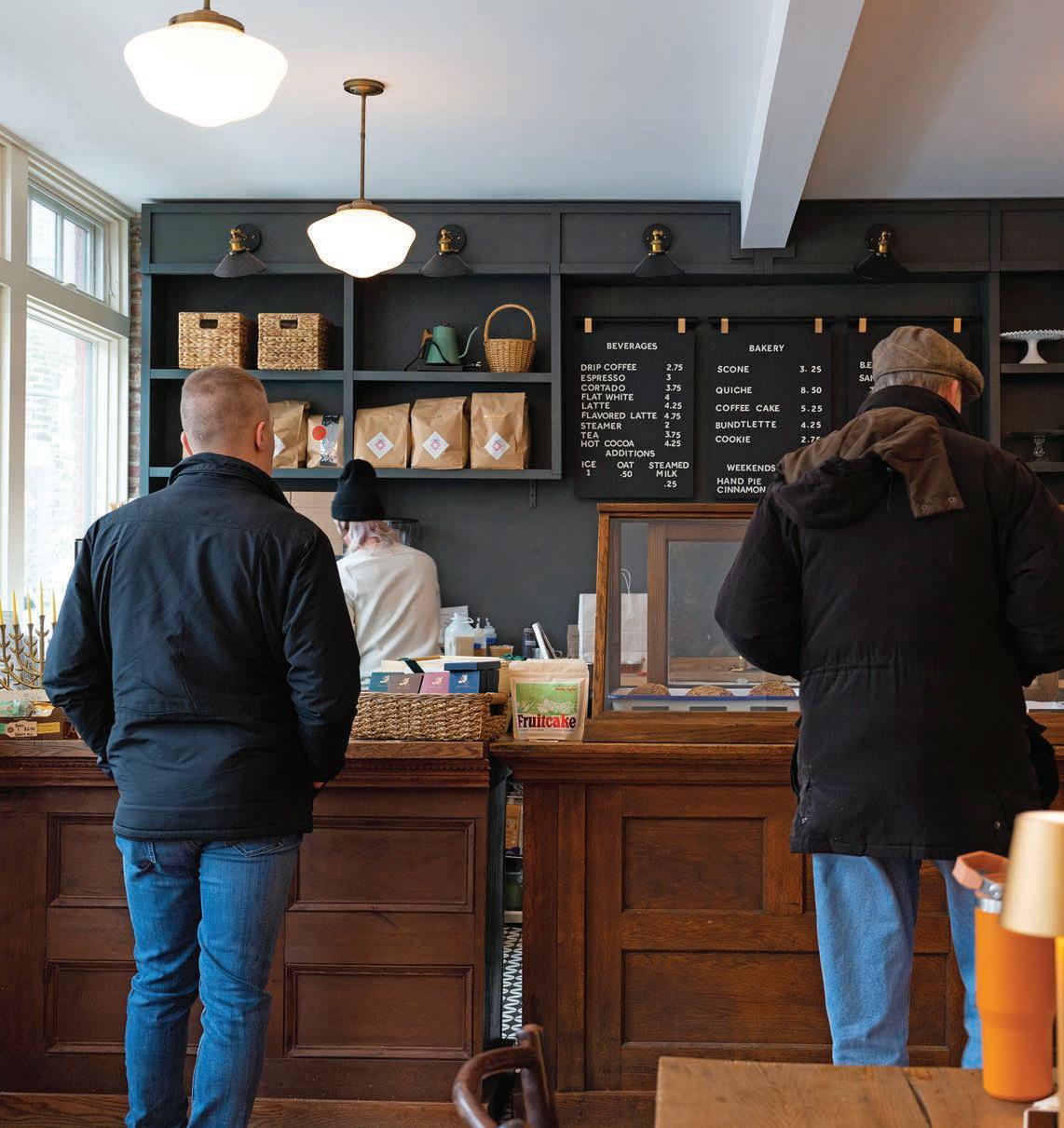





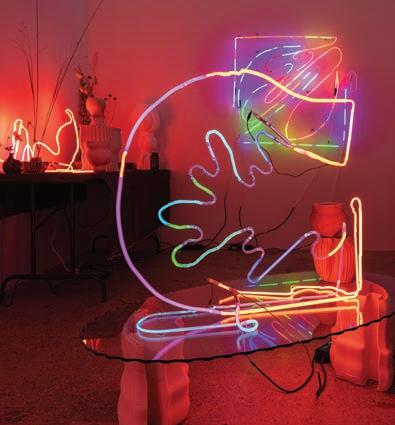


Rachel Strader ’02 creates illustrations that focus on natural science, the beauty of the environment and fostering a desire for ecological conservation. At the helm of Artisans Asylum, Antonio Viva ’95 cultivates learning and a love for creative making of all kinds. Kelly Xi ’17, fascinated by the metabolism of materiality, uses her art to explore humanity’s relationship with other organisms. And at the Guggenheim, Clara Boesch ’14 harnesses technology to enhance museum goers’ understanding of, and engagement with, art.
Like generations of graduates before and after them, their Union education was foundational to their success in the art world. Whether it was a caring professor, an inspiring class, an independent study or a term abroad, their experiences were explorative and interdisciplinary.
“The flexibility of being an interdepartmental major allowed me to follow my interests and take classes in subjects I was simply curious about,” said Boesch, who majored in American studies and minored in film studies. “I took history, art history, English, sociology, anthropology, all of which contributed to my career path.
“But I also liked to express myself creatively and took classes about making— drawing, photography, digital art, film production and even some engineering courses. All have had an impact on my current work.”
Stories like Boesch’s demonstrate the power of a Union degree in the art world, where all manner of fields, businesses, people and ideas intersect. They reflect the essence of Union—a community that embraces and appreciates the interconnectedness of art and other disciplines.
“We often hear that an artist should seek out engineering or science as a fallback. This thinking is flawed,” said Fernando Orellana, associate professor of digital arts. “The reason training in those disciplines is so important to a creative person is because it is elemental to their success.”
Orellana notes that throughout history, when art and industry combine, new inventions, possibilities and markets emerge.
“Every young person who is serious about becoming a professional artist or creative should get a solid foothold in digital practices,” he said. “Through it, they exponentially increase the probability that they will thrive in a creative field.”
Sophia Rothberg ’26, a visual arts major who intends to minor in digital media, takes Orellana’s point to heart.
“I chose to study art at Union instead of an art school because I did not want to limit myself to only taking art classes,” Rothberg said. “Although art is my passion, I wanted to have a chance to take other types of classes, like Chinese or computer science.”
Rothberg has always loved animation, particularly the Disney and Cartoon Network variety. She said blending computer science with art will “help me achieve my dream of making my own animated movie because most animations are made through the use of computers.”
Though still at the beginning of her Union journey, Rothberg is already impressed with the Visual Arts Department, including attentive faculty who are noted artists themselves and facilities that are among the best at small liberal arts colleges.
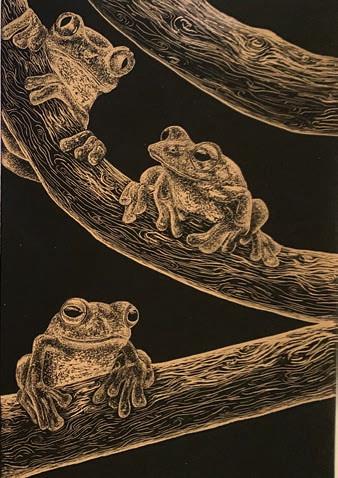
In addition to working in the fully equipped digital media lab, students can meet their muse and make their mark in spacious, light-filled painting, drawing, sculpting and printmaking studios. A large
 Sophia Rothberg ’26 completes a fall term project in the drawing studio.
Sophia Rothberg ’26 completes a fall term project in the drawing studio.
photography darkroom, photography suites, woodworking shop, welding studios and two professional galleries round out the stellar resources available to undergraduates.
On the curricular level, exciting opportunities abound for students to mix courses and fields until they find the perfect match for their interests.
“At Union, the visual arts inherently exist at the intersection of many areas of study,” said Lorraine Morales Cox, associate professor of art history, chair of the Visual Arts Department and co-director of digital media.
She cites everything from courses on Environmentalism and Globalization in Contemporary Art to learning the chemical make-up of pigments in The Art and Science of Painting. Another course that has become increasingly popular is The Business of Visual Art and Entrepreneurship, in which students work in teams to design, develop and pitch their business proposals. All of this, Cox noted, requires market analysis, web design, social media research, financial forecasting and more.
Beyond the classroom, Union offers countless ways for students to enrich their knowledge and expand their experiences.
Every term, art students take a trip to New York City to visit galleries and museums. Often this includes studio visits with renowned artists or private tours of Sotheby’s showroom. And a spring 2022 term abroad in Florence saw students melding disciplines while immersed in Italian art and culture.
“We used iPads to digitally draw and paint, and created augmented reality experiences using photogrammetry, photography, 3D modeling, interactivity and animation,” said Orellana, who led the program. “Students also mixed in art history, as they were asked to respond to art they were seeing at galleries and museums.”

“ At Union, the visual arts inherently exist at the intersection of many areas of study.
– Lorraine Morales Cox, chair of the Visual Arts Department
In the third piece of a series, "Allegory of the Flower," Abby Ellis '20 explores the juxtaposition between femininity and nature. She writes, "There is an undeniable truth that both women and nature have often been overlooked, however when these two forces come together they represent a powerful intertwine and a beautiful alliance." A digital art and illustration piece, it was her final project for Intro Digital Art 2018 with professor Fernando Orellana.
Faculty are continually exploring innovative ways to help students make an idea into something tangible.
Take last spring’s inaugural Post-Digital Printmaking course. Taught by visual arts instructor Allison Conley, it combined “the tradition of printmaking with the everexpanding world of digital fabrication.”
Students explored the theme of “Now.”
“I asked them to create images to express a topic that is uniquely pressing or urgent. Each artist drew from personal experiences that they manifested onto oversize wood blocks carved with a CNC machine,” Conley said. “For instance, one student was exploring the pivotal decisions they would have to make immediately after graduating.”
Conley worked closely with Cole Belmont, who directs Union’s Makerspaces, including one in Feigenbaum Center for Visual Arts that houses the CNC router. Her students also used the laser-cutting lab in Feigenbaum and 3D printers.


The Makerspaces serve Union students and faculty in all fields, providing accessible hubs for creativity and innovation. Intentionally housed in diverse academic buildings, they include the Imagine Lab in the Wold Center and the Make Lab in the engineering machine shop. All support experimentation and hands-on learning.
 Student artwork from the course Post-Digital Printmaking is displayed.
Student artwork from the course Post-Digital Printmaking is displayed.
“These interdisciplinary labs offer students spaces, resources and training that can help bring their ideas to reality. They can test, refine and express themselves creatively as they make physical objects,” Belmont said. “These acts of creation are an extension of critical thinking and learning through doing.”
Using sophisticated digital fabrication equipment greatly expands students’ ability to create things, Belmont stressed. “They are able to augment traditional crafts with digital tools and to create new hybrids and innovative pieces of art and design.”

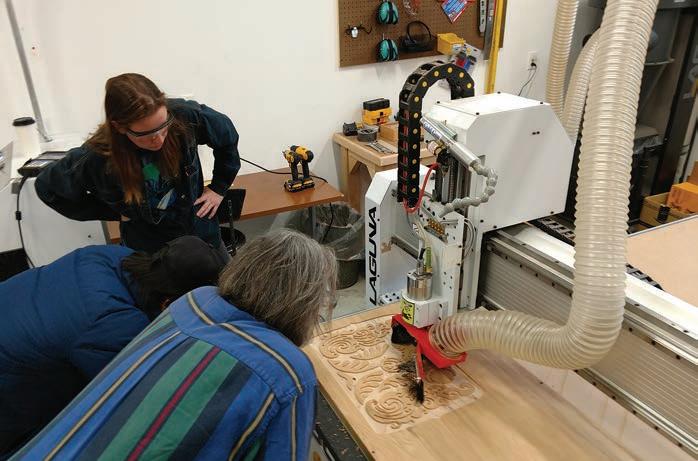
At their core, the visual arts encapsulate many of the qualities that make a Union education distinctive. They blend creative, collaborative and entrepreneurial thinking in an environment that promotes personal development.
“We live in an age in which adding to one’s skill set through a range of media and technologies is critical for future work,” Cox said. “Adaptability, imagination, visual analysis and the iterative process, for example, are central to all creative practices.”
“ These interdisciplinary labs offer students spaces, resources and training that can help bring their ideas to reality. They can test, refine and express themselves creatively as they make physical objects. These acts of creation are an extension of critical thinking and learning through doing.”
– Cole Belmont, Makerspaces directorChris Duncan, May I. Baker Professor of Visual Arts, Abby Golodik '18, former art studio technician, and Thomas Aung '20 work in the Maker Web CNC Lab.
Top: This digital landscape painting was Forrest May's '24 final project in a digital art class last fall.

Bottom, left: Tina Tully '21 used the CNC machine, a subtractive digital fabrication tool, to carve foam into large-scale relief portraits that come directly from digital photos and line work created in Adobe Illustrator. The piece was exhibited in the Crowell and West Galleries Senior Show (spring 2021).

Bottom right: Claudia Porto '25 created this digital drawing in November 2021 for her digital art class. She writes, "This drawing encompasses the present issue of body dysmorphia and the effects it has on the mind and the body. Our perception of ourselves is skewed in alignment with the mind."

Union graduates, like those featured here, are thriving in the art world. Their multifaceted educations in Schenectady have played an important role in their careers.
With backgrounds and distinguished careers in science and medicine, Gail GoodmanSnitkoff and Lou Snitkoff are also creatives and avid art collectors. She’s a microbiologist and immunologist who designs jewelry; he’s a physician and photographer. They have been making and supporting art for most of their lives, including as the former owners of an award-winning gallery in downtown Troy, N.Y., that featured the work of more than 90 artists.

Gail Goodman-Snitkoff
MAJORS: Biology and chemistry
Gail Goodman-Snitkoff credits Union’s comprehensive education requirements for fostering her love of the humanities and “how to think about things other than science.”
A voracious reader, she gravitated toward English courses.
“It was wonderful. I was encouraged and welcomed into those classes,” she said. “I took poetry; I read Joyce’s ‘Ulysses.’ Professor Hans Freund was very influential. I remember knocking on his door and saying, ‘I’m a science major. Can I take your class?’ He gave me a resounding, ‘Yes!’”
After graduating from Union, GoodmanSnitkoff earned a Ph.D. in microbiology and immunology from SUNY Downstate Medical School. In 2002, she went back to school part-time to earn a master’s degree in medical humanities from SUNY Empire State College, where she studied feminist theory and medicine.
Her career in academia spans 40 years. In the mid-1980s, she briefly taught biology at Union and held an adjunct position at the University of Albany. In 2018, GoodmanSnitkoff retired as an associate professor after teaching for 27 years at the Albany College of Pharmacy and Health Sciences. She began making jewelry in 2005.
“I started playing with polymer clay, manipulating the clay into tiny balls, making earrings and necklaces,” she said. “I was inspired by the landscape in Rockport, Mass., where things collect in the rocks or cracks, and you get new growth and changes, a kind of metamorphosis.
“I began filling up negative space and painting on top of the clay, then embedding pearls and glass beads. The jewelry has value not because of precious metals or stones but because of the artistic intent behind it.”

Goodman-Snitkoff realized a longtime vision when she and her husband, Lou, opened Pause in Troy in 2018. Months after being named a top Capital Region art gallery, it recently closed due to pandemicrelated issues.
“Our dream was to support local and regional artists and fine craftspeople,” she said. “I remain humbled by the generosity of the artists we worked with and incredibly grateful for the opportunity.”
For Goodman-Snitkoff, embracing and making art are “the yin to the yang of the science. Science is more hypothesis-driven and experimental. Ultimately, it doesn’t have the same tactile and emotional resonance for me that holding a piece of artwork does.”
Lou SnitkoffIt was a double exposure of sorts for Lou Snitkoff, whose rigorous academic schedule included a mix of pre-med science requirements plus some elective courses in the humanities.
“Union was on the cutting edge of requiring students to take a range of disciplines. The objective was to introduce you to a broad scope of thinking,” said Snitkoff, a graduate of SUNY Downstate Medical School.
In addition to studying creative writing and Greek civilization, Snitkoff enjoyed a course in Scientific and Technical Photography, in which he photographed lasers and diffraction patterns.
“We studied the physics of light, which included darkroom work.” he said.
He continued to use Union’s darkroom after the course was over, laying the foundation for a lifetime of artistic photography.
An internist, Snitkoff was a founding member and Chief Medical Officer of CapitalCare Medical Group, and later served as vice president for the Ellis Hospital
Medical Group in Schenectady. He retired from practicing medicine in 2020.
Throughout his life, making photographs has remained a constant focus and source of balance for Snitkoff. He has concentrated on the natural landscape, botanicals, and abstract and macro work (extreme closeups of something small), as well as architectural details.

He describes his photographic aesthetic as minimalist, with a diverse color palette that ranges from deeply saturated to neutral. He exhibits regionally, and his photographs are in numerous private collections.
His most recent series, “Fog,” which was on exhibit at Pause Gallery, features atmospheric images that illustrate his long-standing affinity for “a weather condition that cloaks everyday subjects in a veil of subtle mystery” and, as far as he is concerned, “occurs far too infrequently.”
Above all, he believes that photographs should capture the essence of a location or space.
“This may be a particular characteristic of the place itself or a feeling instilled by being there as a thoughtful and attentive observer.”
Polymer clay jewelry by Gail Snitkoff '74 (Photo by Lou Snitkoff '73)Antonio Viva ’95
MAJOR: English
MINOR: Theater
FURTHER EDUCATION: MAT, Union College (now Clarkson University)
TODAY: Executive director, Artisans Asylum
Artisans Asylum is the embodiment of Antonio Viva’s passions—art and education. Its tagline says it all: Learn. Make. Teach.
The non-profit community makerspace offers affordable studios, shared workshops, classrooms and communal spaces used by artists, makers, entrepreneurs and students. Its mission is to advance the learning, practice and culture of do-ityourself fabrication, as well as cultivate and foster a love for making of all kinds.

“Art and education are both inherently human-centered practices. Art has the ability to remind the world that humans are capable of making beautiful things,” Viva said. “Given the headlines that inundate us daily, artists have an added responsibility. Not only can art connect and unite us, but it can and must hold a mirror up to society.”
Education, he emphasized, is the foundation from which a modern society invests in the future.
“I continue to believe that the future we hope to see begins with creating education systems that are equitable and provide all students access to follow their dreams. The intersection of art and education is where infinite possibilities lie.”
Viva first learned this at Union.
“An astronomy class I took for non-science majors influenced a play I
wrote in 1996 called ‘Dark Matter,’” he recalled. “And being able to take a seminar on the life and work of Gertrude Stein back in 1994 when queer writers were not as widely taught was deeply influential.
“I think Union was and continues to be an incubator for creative ideas and expression. It creates an environment that is conducive to making new things,” Viva
said. “My time at Union fostered a sense of taking creative risks and having the courage to try new things. It also taught me how to be a lifelong learner, something I am deeply grateful for.”
Learn more about Viva and Artisans Asylum at artisansasylum.com
Rachel Strader ’02
MAJOR: Biology
MINOR: Sociology
FURTHER EDUCATION: Science illustration, California State University, Monterey Bay; Master of Environmental Management, Duke University
TODAY: Painter and science illustrator
Rachel Strader didn’t experience the ocean until she was 12. Since that young age, “the ocean, art and conservation have been currents flowing through my winding path.”
At Union, Strader went on a marine studies term abroad that was a major influence on her career. After graduating, she spent more than a decade working on marine conservation research and strategy for a philanthropic foundation. Seven years ago, when considering returning to school for scientific illustration, she remembered how much she loved The Illustrated Organism, a dual-listed biology/ arts course at Union.
“It was a great way to sneak in some art for this biology major in my senior year,” she said. “It ended up being one of the most rewarding—and challenging— courses I took.”
Though she didn’t realize it at the time, the course was created by Professor of Biology Carl George (now emeritus), with whom her father, Dr. Stephen Strader ’72, had studied. She had heard about the ecology classes her father took with him.
“It seems like Professor George influenced my path a lot, though I never met him,” she said.
Now based in San Francisco, Strader supports philanthropy for conservation, science, art and environmental education as executive director at the Maxwell/ Hanrahan Foundation. Her freelance science illustration focuses on natural science, the beauty of special places and the creatures that make their home there.

In 2021, Strader was part of a project for Ocean Conservancy, which collaborated with the Pacific Fishery Management Council’s Climate and Communities Initiative. She created illustrations that describe different scenarios for West Coast fisheries, ecosystems and communities considering climate change. Her artwork was designed to help stakeholders visualize different options for making smart decisions.

“I use color and composition to enhance ecological stories,” she said. “Whatever medium, my work always aims to set a mood and put the viewer inside the environment—hopefully inspiring them to care more about its lasting health.”
Learn more about Strader at rachelstrader.com.
MAJOR: American studies
MINOR: Film studies
FURTHER EDUCATION: Bard Graduate Center

TODAY: Manager, digital experience, Guggenheim Museum
If you’ve visited the Guggenheim recently, chances are you’ve encountered some of Clara Boesch’s work. She’s the one in charge of producing the museum’s audio guides and app, as well as managing the general Guggenheim app.
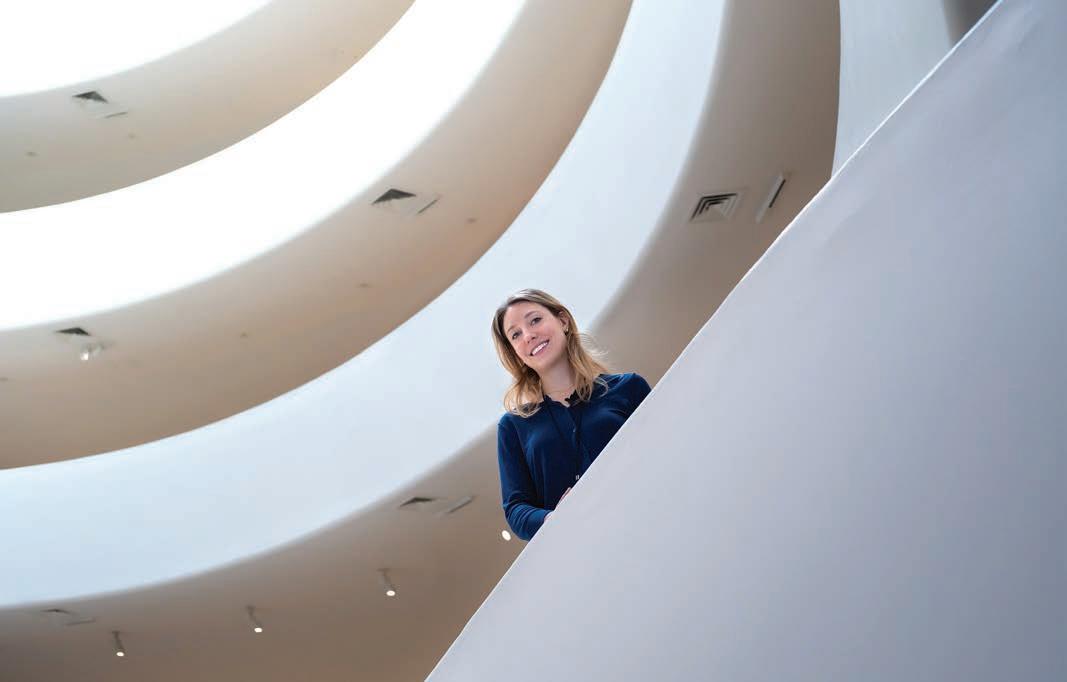
A member of the digital department there, Boesch’s job is inherently interdisciplinary.
“I strategize with others on my team and in other departments about the stories we want to tell in the digital/physical space. It’s a bit like producing a documentary,” she explained. “I do research, organize
and conduct interviews, develop scripts, plan recording sessions and work with editors and musicians. Each project has to balance different perspectives, from the artist to the curatorial team, visitor experience team and funders.”
“My colleagues come from very different backgrounds and have very different roles than I do—from their experiences in education, community development, sustainability, fundraising, marketing, engineering and so on,” she added. “Museums and the art world are interdisciplinary places. And I think today, especially art museums are rethinking their roles in their communities and how to be more relevant. Effective interdisciplinary thinking can certainly support that and push ahead change and innovate ideas.”
Boesch’s own background is similarly multidimensional, with her time at Union being no exception.
“The Business of Visual Arts and Visual Culture, Race and Gender gave a great foundation to the art world. I took some excellent film classes to explore my interest in in storytelling, media and production, and some courses in digital art,” she said. “I also took part in the Civil Rights mini-term, thinking critically about race in American public history, which is incredibly relevant to museum work today, not to mention the world at large.”
Learn more about Boesch, and get a peek inside the Guggenheim, in this video.
MAJOR: Biology and visual arts, interdepartmental
FURTHER EDUCATION: Studio MFA candidate, School of the Art Institute of Chicago (SAIC)


TODAY: Neon Lab technician, Art & Technology Department, SAIC; freelance installation artist, media designer & 3D animator
For Kelly Xi, art and science are inseparable, intimately intertwined and completely complementary. She couldn’t create her works without one or the other. Both are indispensable for generating her brand of art and the self-reflection—of our relationships with other organisms—that this art sparks.
She is drawn, for example, to exploring how stuff is broken down, eaten or otherwise used by lifeforms—and the relationship (think coevolution and mutualism) between them.
“I’m most interested in the metabolism of materiality, and through embodied storytelling, I aim to advocate for direct alliances with organisms that support our ability to live,” explained Xi. “I robotically print fiber-ceramic decomposer habitats to circulate aerobic breakdown, for instance. I make glass exoskeletons for ultraviolet current, so algae can synthesize polymer from light.
“We can conceive differently what we regard as waste by acknowledging common benefits shared among nonhuman agents,” she added. “Collaborative aerobic breakdown supports nutrient cycling, water retention, biodiversity and ecological resilience.”
While bringing art and science together like this might seem daunting to some, Xi never shied away from it, thanks to Union.
“I wasn’t afraid to approach technologies new to me because we were already working with bacterial genomes with professor Stephen Horton and fly embryo
neurodevelopment with professor Quynh Chu-LaGraff,” she said, referencing her biology professors. “A foundation in research practice shaped my artistic methodology and curiosity for discourse. In media art, the humanities offered crucial context and social grounding to understand the implications for how emerging technologies are deployed.”
“Humanities help clarify how our actions embed in the social fabric,” she noted, “and ecology helps us understand how they integrate in systems beyond the human.”
Learn more about Xi at www.xikel.xyz/
Organelles of Extrahuman Timescale: ceramic decomposer habitats, food waste and packaging compost, invertebrates. (Installed in SAIC Graduate Studios, 2022)
(Photo by Eugene Tang)
Kelly Xi ’17 with her Exoskeletons for Photic Current neon sculptures: recycled glass, phosphor minerals, electronic transformer, freshwater algae (installed in SAIC Graduate Studios, 2022) (Photo by Eugene Tang)Additional stories, featuring the following alumni, are available online at union.edu/magazine.
Kimberly Ferguson ’15, freelance artist and educator

Abby Golodik ’18, graphic designer and sculptor
Lauren Karp Kinghorn ’91, art therapist and printmaker


Stephen Nadler ’21, photographer

Chet Urban ’93, multimedia artist

Union has felt like home to me since age 5, when I first stepped on campus to visit my sister, Drena Root ’87. Union provided me with platforms to grow intellectually, enabled me to discover interests that became lifelong passions, and gave me a network of friends that have become family. I choose to give back to Union, and double my gift through my employer match, because I want to ensure that current and future students are gifted with the same opportunities.”
—DENISE WEBSTER ’01, VP, GOLDMAN SACHSMany employers sponsor matching gift programs and will match charitable contributions made by their employees to encourage philanthropy. By simply completing a matching gift form with your Human Resources office you can double, possibly triple, the impact of your annual gift to Union College.
Find out if your company has a matching gift policy by visiting ualumni.union.edu/waystogive.

For assistance, contact the Office of Annual Giving at (518) 388-6175.

Donald R. Thurston, professor emeritus of Asian Studies, spent his teaching career helping students fall in love with Asia just as he did seven decades ago.
With the establishment of an endowed professorship, he aims to continue that legacy for generations to come.
The Donald R. Thurston and Robert Englebach Professorship in Asian Studies, is named for Thurston and his late husband, both steadfast supporters of Union’s comprehensive approach to Asian Studies.
Thurston’s gift of $2.5 million is one of the largest gifts to the College from a faculty member.
Thurston, 93, taught Asian Studies at Union from 1966 until he retired in 1996. For those 30 years, he had a joint appointment in History and Political Science. He was on campus Nov. 1, 2022, to sign a gift agreement and attend a reception in his honor.
“Throughout his teaching career and beyond, Professor Thurston has continued to expand our curriculum—and our
students’ perspectives—literally around the world,” said President David R. Harris. “His gift will ensure that his transformative impact continues well into the future.”
“In a profound way, Don helped to lay the foundations for the interdisciplinary program that Asian Studies is today,” said Sheri Lullo, associate professor of Asian Art History and director of Asian Studies. “He taught history and political science, but also initiated the study of Asian culture and art at Union. And now, this recent gift continues his legacy of expanding the many perspectives we can offer to students in the study of Asia.”
“It is not a stretch to say that the first 1986 Union College term abroad to Nanjing, China, changed my life,” said James Sawyer ’88. “Thanks to the passion and love of travel that Professor Thurston passed along to all of us, and his love for Japan and Asia, I had an incredible and unforgettable experience in China.”
Through his gift, Thurston envisions a faculty member who is engaged with the people of at least one Asian country, is fluent in their language and understands their culture from having lived with the people for a few years. The scholar would be based in a department ranging from music to history or anthropology, but with two-thirds of their courses each year in Asian Studies, which Union offers as a cross-disciplinary program.
In 1989, with the help of many faculty, Thurston founded the East Asian Studies program. Students could major in the

program by studying Japanese or Chinese, taking required courses and a few electives. His goal: to open students to the great and different civilizations of Japan and China. Englebach, who retired as a quality systems engineer at GE, established the Robert G. Englebach Endowed Fund for Asian Studies through his estate. Having traveled to Japan six times to see Thurston for two weeks each time, he knew the importance of supporting students to study there. The couple, who took major trips each year with destinations including China and India, was together for 37 years until Englebach’s passing in 2015.
Of his gift, Thurston said, “I hope this will help students to respect all the peoples of Asia and stimulate them to maintain a lifetime interest in Asia.”

To learn more about Thurston and his gift, visit union.edu/news
Donald Thurston, top right, leading the College’s inaugural term in China in 1986
“IT IS NOT A STRETCH TO SAY THAT THE FIRST 1986 UNION COLLEGE TERM ABROAD TO NANJING, CHINA, CHANGED MY LIFE. THANKS TO THE PASSION AND LOVE OF TRAVEL THAT PROFESSOR THURSTON PASSED ALONG TO ALL OF US, AND HIS LOVE FOR JAPAN AND ASIA, I HAD AN INCREDIBLE AND UNFORGETTABLE EXPERIENCE IN CHINA.”
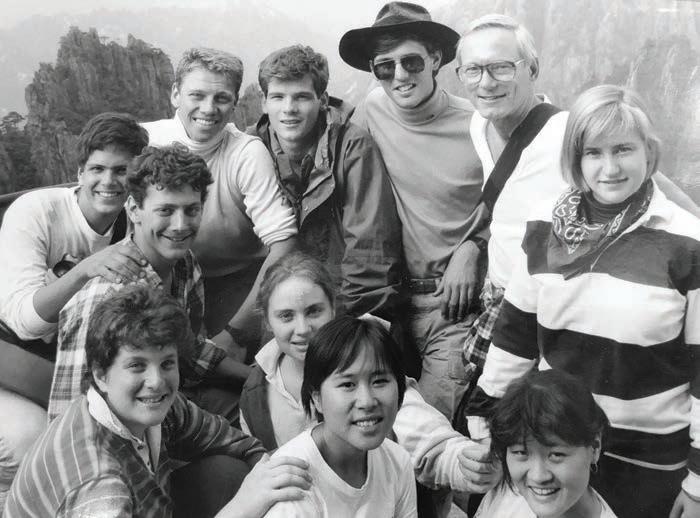
– James Sawyer ’88

CAMPAIGN PRIORITIES:
Ensuring Access
Propelling the Liberal Arts and Engineering
Developing Students Beyond the Classroom
The Union Fund
Facilitating intentional connections between what happens inside and outside the classroom is a cornerstone of Union’s mission, and that of the Powering Union campaign. Generous alumni and members of the Union community are a critical part of this. Your support makes it possible for students to develop a deeper understanding of themselves, this world and the role they play in shaping its future.
Here are just a few examples of where such development beyond the classroom occurs at Union—and how valuable this melding of traditional and nontraditional learning is to preparing students to lead in a world of multiple tomorrows.
Donors to the Powering Union campaign have made each of these opportunities possible. Thank U!
Union’s new residential curriculum focuses on enhancing life skills of all kinds for students, with many lessons, workshops, mentoring sessions and experiential adventures led by residence advisors. This peer-to-peer structure often benefits the RAs as much as it does residents.
Residence advisor, Davidson Hall
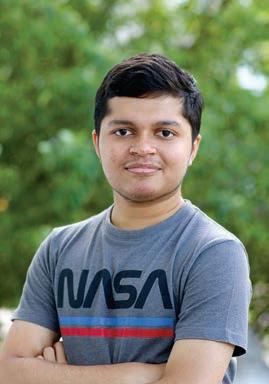
Post-Union goal:
Advanced degree in robotics/artificial intelligence
To learn more about Powering Union:
The Campaign for Multiple Tomorrows, visit union.edu/powering or contact Scott Rava, assistant vice president for principal gifts and campaign director, at ravas@union.edu or (518) 388-6481.
U Journey really benefits me and my peers by providing opportunities to connect with people and develop soft skills like communication, leadership, teamwork and organization. Being an RA has been one of my life-changing experiences. I have become more effective in my communication, in contrast to my introverted past where I tried to avoid interactions due to fear of the unknown. Definitely, being an RA has turned my fear into curiosity to the point that I am now attracted to leadership roles on campus.
The College is proud that 60% of students spend a term studying abroad or away from campus. And with good reason. Few experiences beyond the classroom have more lifelong impact than getting way out of your comfort zone in an unfamiliar city or country.
Australia term abroad (fall 2022)
Post-Union goal: Graduate degree in freshwater ecosystems
The Chelsea Leigh Cobb Class of 2008 Term Abroad Fellowship supported Caitlin’s term in Australia.

My term abroad helped me realize that I am capable of taking on challenges and adapting to new environments. Before going on this trip, I would ride my bike to places occasionally, but I would usually drive my car because it is easier. Since being in Australia, I have ridden my bike everywhere I need to go. I have come across carpet pythons on the bike path, I have been swooped by Australian magpies, I have ridden through a flood, and I am still standing! I feel as though all of these things have given me the confidence that I need to conquer future challenges.
Actual hands-on, real-world experience is irreplaceable when it comes to helping students chart their career course after graduation. Union has myriad programs in place to help students secure internships appropriate to their fields and interests.
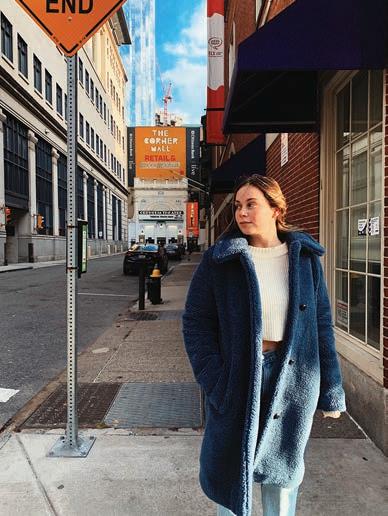
Internship: St. Peter’s Parish food pantry and free health clinic, Worcester, Mass. (summer 2022)
Post-Union goal: Physician assistant
Natalie was a recipient of the Class of 1973 Community Service Internship, which helped fund her time at St. Peter’s Parish.
I am grateful not only for the knowledge I gained through this internship, but also that I contributed to increasing accessible health care that social determinants limit. By exploring the world of health care in different ways and applying skills acquired through this internship and at Union, I hope to further develop my understanding of social determinants to better treat patients in an effective and compassionate manner. This internship allows students to learn outside the classroom and witness firsthand the issues that affect their neighbors, inspiring future action in the career path they choose to take.
Research is a perfect example of the type of immersive experience Union provides students in all fields, from music majors to mechanical engineers. Working alongside professors in labs or getting out into the field makes students active participants in, and contributors to, their disciplines.

ECONOMICS
Summer research topic: Iambic pentameter in Renaissance poetry
Post-Union goal: English doctorate
Union has a robust program to ensure first-year students feel at home and thrive on campus. That they know faculty, staff and other students are here to guide and inspire them, help them in all capacities, and share in their adventures. The pre-orientation experiences are wonderful examples of this. These innovative threeday programs help incoming students make connections and give them a jump-start on their college experience before the formal orientation begins.
Outdoor pre-orientation (Adirondacks)
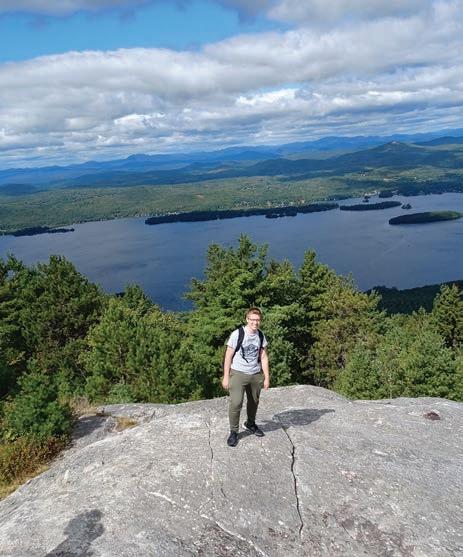
Post-Union goal: Manage superfund cleanups, halt planetary pollution
I was curious to understand how structural linguistics governed and affected the cadence and meaning of iambic pentameter. This summer research project was my first introduction to longerform work. I explored a topic relevant to my coursework and bolstered my understanding of poetic form and construction, while also gaining ample time to think, clarify and revise a work with much greater focus than during a single term. This kind of opportunity is incredibly valuable in preparing students for a senior thesis or capstone project. I have applied what I learned from the research process over and over again in my economics and English theses.
We scaled the summit of a mountain, pushed through the cold air at morning polar plunges, and even beat the most difficult rope course that could be taken on. The people I met in my cabin and at those activities became my community and first friend groups at Union. Every single activity was an opportunity to make ourselves feel welcome and safe in a small group, so we could feel the exact same level of comfort when we got to campus and it was time for us to venture out into the wider school population. Pre-O was a preparation phase to hone our social skills and encourage vital early connections that will stay with us through the rest of the school year and onward into the future.
At Union, class deans guide students to resources in all areas of life inside and outside the classroom. All students work with the dean of first-year students during their first year on campus. Then students are matched with deans who will follow their class through the next three years, ensuring a constant source of support, encouragement and advice during the entirety of their academic careers.
Robin Olinsky Class Dean, Class of 2023The most rewarding part of my job is watching a student learn how to make difficult decisions. As a class dean, it’s my job to answer questions and to help students identify the pros and cons of each decision they make, but ultimately, it's up to them to decide. As a student determines their path through Union, their decisions provide a chance to learn, experiment, fail and celebrate. Learning how to make a decision, weighing their options, then dealing with the consequences are some of the most important lessons we can teach our students to prepare them for their lives after Union. It is a privilege for me to be able to watch them develop these skills and be a part of this process.
Union has 24 Div. III sports teams, plus Div. I men’s and women’s ice hockey. So for hundreds of students, athletics play a vital role in personal development, health and happiness. Recognizing the power of sports, and the essential role many coaches have as mentors—on and off the court— Union is working to endow coaching positions in all programs.
Maura Conan ’24 PSYCHOLOGY

Women’s basketball, point guard Post-Union goal: Physical therapy doctorate
Playing basketball at Union has allowed me to enrich and further excel in my education. The sport, my teammates and coaches have taught me important life skills I will benefit from even after college—time management, communication, collaboration, accountability. I have gained a second family in my team that I otherwise would not have had. And the leadership of these teammates has allowed me to get out of my comfort zone, all while knowing they have my back and my best interests in mind.

For Union College hockey, the time is now. With the recent reversal of a longstanding NCAA policy that prevented Union from offering athletic scholarships to its Division I athletes, the hockey programs now have the opportunity to compete on a level playing field with their peers.

In his first season as head coach, Josh Hauge has brought new enthusiasm to the men’s team. His staff continues to work toward bringing Union back into the national conversation, buoyed by an excellent first-year class. Meanwhile, head coach Josh Sciba led the women’s team to its most successful season ever in 2022-23, setting a new program record for wins at the Division I level and earning its first victory over a nationally ranked opponent.
Now, with the ability to award scholarships to deserving student-athletes for the first time, Union hockey is poised to take the next step forward.
“We are extremely excited to be phasing athletic scholarships into our 2023-24 season, and we appreciate the support that Union College has invested into the hockey program and the future of these young men,” Hauge said. “This decision gives us the ability to provide an unbelievable education to outstanding student-athletes. In the ever-changing and competitive athletic landscape, the ability to offer scholarships allows us to compete on a national level.”
“We are so honored to be part of the decision to grant athletic scholarships,” Sciba said. “We now have the ability to alleviate financial hurdles for families, which has instantly created an advantage for us on the recruiting front. It also gives us the opportunity to attract more top tier studentathletes who will drive our program forward both on and off the ice. We are extremely excited about the future of our program.”
For years, multi-classified schools that compete primarily in Division III and sponsor one Division I sport (ice hockey in Union’s case) were able to thrive without the benefit of athletic scholarships. However, dramatically shifting dynamics in collegiate sports have changed this.
An increase in college ice hockey programs and league scholarship limits has meant the availability of more athletic scholarships, and NCAA rule changes have made it difficult for schools without scholarships to retain their top talent. In 2021, for example, the NCAA began allowing all athletes to transfer once without having to sit out a season. This meant that players could begin their careers at Union, gain
valuable experience and exposure, and then be eligible to play the following season at a school offering scholarships.
With the 2022 NCAA policy change, Union’s ability to award athletic scholarships will level the playing field, allowing the College to attract and retain outstanding student-athletes and strengthen its nationally competitive hockey programs.
Union hockey dates to 1903, when the men’s team first competed at the intercollegiate level. The men began Division I play in the ECAC during the 1991-92 season. The women’s club hockey team, founded in 1994, began play at the Division III level in 1999 and was elevated to Division I in 2003.
Union’s hockey players have long proven themselves as dedicated competitors, learners and leaders.
n They routinely post overall GPAs at or above the student body average.
n Combined, both squads have averaged 34 ECAC All-Academic Team selections annually over the last decade.
n Since the creation of the AHCA All-American Scholars award in 2017, Union has earned 45 selections over the last six years: 25 women and 20 men.
n Four players have been named ECAC Hockey StudentAthlete of the Year since 2007, the most of any ECAC institution.
n Eight student-athletes have been nominated for the prestigious Hockey Humanitarian Award.
Players have also made a significant impact in the community. Here are just two outstanding examples.
Josh Kosack ’21 founded Kozi’s Kids to introduce local children from Schenectady’s C.O.C.O.A. House (Children of Our Community Open to Achievement) to the sport of ice hockey and Union’s campus. Kosack raised over $50,000 to support the organization and help fund a new Team Empowerment Center. In 2022, he won the Hockey Humanitarian Award and the ECAC Hockey Student-Athlete of the Year award.
Grace Heiting ’22 gave back as a campus Gift of Life ambassador for three years and also served on the College’s Honor Council. In 2022, she was named a Capital District Sports Woman of the Year and earned Union’s Senior Female Athlete of the Year award. Heiting also was a finalist for the Mandi Schwartz Award, presented to the ECAC StudentAthlete of the Year.
Union hockey is at a critical inflection point. For the first time in the history of the programs, Union has the opportunity to play on equal footing within the league and nationally in Division I. Coaching staffs will be able to offer full or partial scholarships to incoming recruits or current players, which will help attract and retain individuals with great athletic potential, academic ability and leadership qualities. These scholarships, coupled with the educational opportunities and outcomes available to prospective student-athletes, will make Union a destination for the best and brightest.
Division I hockey institutions are able to provide up to 36 athletic scholarships—18 for men and 18 for women. Union College will fund 30 scholarships—15 for men and 15 for women—that will be phased in over the next three years.
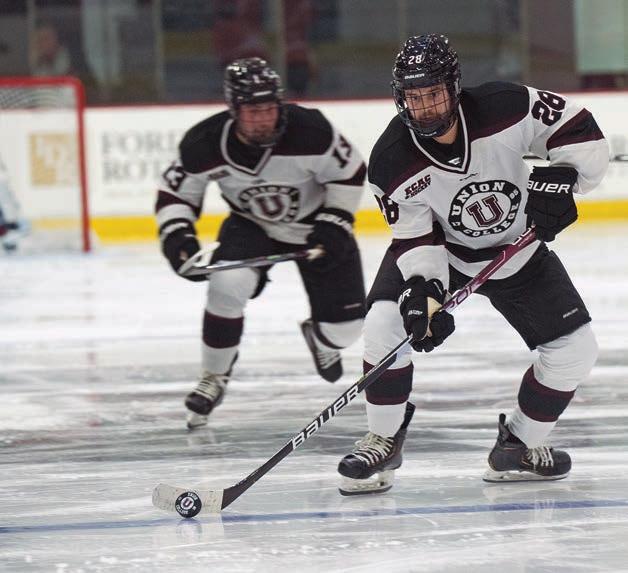
The College recently launched a $10 million fundraising campaign to endow the remaining six scholarships. This will provide coaches with the full complement of 36 scholarships—a win-win for student-athletes and Union’s longstanding tradition of academic and athletic excellence. It will strengthen Union’s competitiveness and elevate the College’s visibility and reputation locally, regionally, nationally and internationally.
Interested in learning how you can be part of this milestone moment in Union College hockey? Contact Scott Rava, assistant vice president for principal gifts and campaign director, at (518) 388-6481 or ravas@union.edu.
There’s a new mural on an underpass along the Albany County Rail Trail in Bethlehem, N.Y. One that’s difficult to describe. Because it’s ethereal and earthly, alien and familiar, comforting and slightly overwhelming—all in one glance. Which makes its name—“Cathedral”—pretty much perfect.
The gigantic space beneath the underpass inspired its creator, Fernando Orellana, to choose the moniker. But “Cathedral” fit for reasons beyond this, too.
“There is also an aura to the space, with the surrounding environment being natural but the structure itself serving this very unnatural purpose of cars zooming overhead,” he explained. “There is a constant hum of automobiles to the underpass, almost like prayers being muttered all the time.”
“As I painted, I also noticed that people take sanctuary under the bridge when it rains or to take a break from the sun,” Orellana continued. “The trail itself feels like a nave, with the constant stream of pedestrians the procession. It’s like a cathedral to nature and people.”
Art on the Rail Trail commissioned Orellana to paint “Cathedral” in February 2022. He began designing the piece in March and completed it in September.
His design process was much like his teaching—very interdisciplinary. Orellana used technology to bring “Cathedral” to life, relying on computer programs he uses in class to craft the piece digitally first.
“Digital art is a discipline that relies heavily on computers and technology to facilitate art making,” he said. “Which begs the question: How does making a monumental mural that was hand-painted by humans fit into that?”

“The truth is that a lot of murals these days are designed digitally first, working out design, color, scale and strategy via a computer before any physical mark is made.”
Orellana began by studying the highway pillars and modeling them in a virtual space using the same Cinema 4D and 3D graphics program he teaches his students to use. He then used an iPad Pro and a program called Procreate to draw directly on the 3D pillar models.
“The technology made it possible to draw on the virtual 3D pillars from any angle, something that would have been much more challenging in 2D,” Orellana said. “This is the reason the imagery on ‘Cathedral’ seems to go in all sorts of directions, almost like the shapes are weightless, bouncing around in a hot pink void.”
He has enjoyed the process of designing and painting “Cathedral” (the biggest artwork
FERNANDO ORELLANA, associate professor of visual arts
Ever wonder what Union professors are up to when they aren’t teaching?
Just about everything, as it turns out. Nothing is beyond their collective reach or curious minds. Here’s a glimpse of the diverse and intriguing work they do.
he’s ever made) immensely. And he wishes the same for those who view it.
“I hope the quirky, colorful and ambiguous imagery serves as a portal to happiness, joy and wonder. That, above all else, was the essence of what I tried to capture in ‘Cathedral,’” Orellana said. “A sanctuary in which the public can put aside the stresses and chaos of the modern age, returning to a simple time of their childhood.
“Certainly, I think the biggest fans of ‘Cathedral’ have been the children, with two of them bringing me cookies one day during production. The children who visit the mural get the message, as they are the native congregation of ‘Cathedral.’”
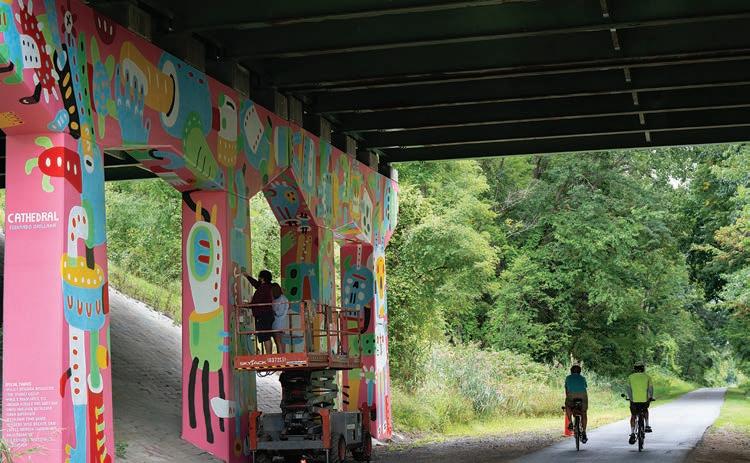
To watch a video of Orellana working on "Cathedral," visit union.edu/news/cathedral
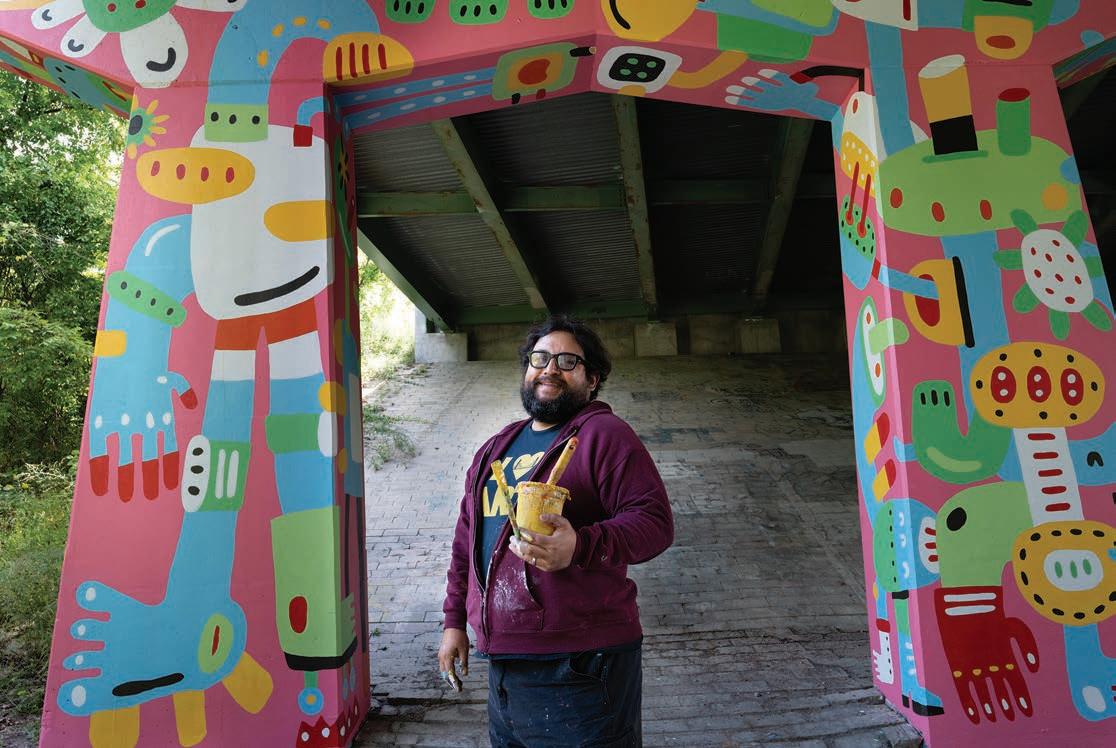
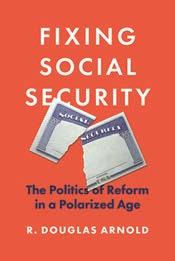
Princeton University Press
Since its establishment, Social Security has become the financial linchpin of American retirement. Yet demographic trends—longer lifespans and declining birthrates—mean that this popular program now pays more in benefits than it collects in revenue. Without reforms, 83 million Americans will face an immediate benefit cut of 20 percent in 2034. How did we get here and what is the solution? In Fixing Social Security, R. Douglas Arnold explores the historical role that Social Security has played in American politics, why Congress has done nothing to fix its insolvency problem for three decades, and what legislators can do to save it. Arnold investigates why politicians designed the system as they did and how between 1935 and 1983 they allocated—and reallocated— costs and benefits among workers, employers and beneficiaries. He also examines public support for the program, and why Democratic and Republican representatives, once political allies in expanding Social Security, have become so deeply polarized about fixing it.
J3Unscripted
In The Right Thing to Do, a sci-fi adventure, a captured alien reveals that the aliens created humans. Humans are just robots. The human race has different reactions to the news. What happens to our values? Should human laws remain? Should we still have compassion for each other? Does killing a human being still have the same meaning? What do you think? Learn more about the book at https://books2read.com/
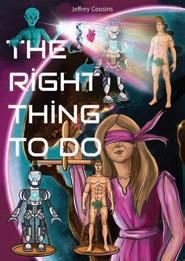
IfWeAreRobots
Daughters of Nantucket

Mira Books
Set against Nantucket’s Great Fire of 1846, this story brings together three courageous women battling to save everything they hold dear. Eliza Macy is struggling to conceal her financial trouble as she waits for her whaling captain husband to return from a voyage. In desperation, she turns against her progressive ideals and targets Meg Wright, a pregnant free Black woman trying to relocate her store to Main Street. Meanwhile, astronomer Maria Mitchell loves running Nantucket’s Atheneum and spending her nights observing the stars, yet she fears revealing the secret wishes of her heart.
DR. DAVID S.
(chapter co-author) Medicine with the Military (chapter of Handbook of Research on Advising and Developing the Pre-Health Professional Student)

IGI Global
The Military Health System is one of America’s largest and most complex healthcare institutions. It offers myriad opportunities for medical training, research, clinical care, and operational experiences as uniformed physicians, dentists and other allied health professionals serving as commissioned officers within the United States Armed Forces. This chapter provides an overview of the Military Health System to include training, research and career opportunities; the day-to-day work of a military medical officer both in a traditional hospital setting and while on deployment; and the most common pathways to becoming a military healthcare professional through the Health Professions Scholarship Program or at the Uniformed Services University.
JESSICA
Letting Go
R&R Press
Letting Go is Deepak Chopra meeting the Salem witches in modern America. Instead of painkillers and antidepressants, Rebecca relieves pain and heals with touch. Dismissed by critics as quackery, her ancestors were hung as witches; but what she can do is amazing, beautiful, and life-changing.
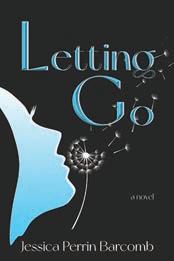
After the death of her mother, the betrayal by her best friend and by the man she thought she would marry, Becca searches for the path to healing that we all seek: The way to let go. Not only do her gifts cross the boundaries to spirit, but will they also heal the man she’s loved the most upon his return from war?
ROBYN POLANSKY
MORRISON ’00
The Good Morning Book
Blue Balloon Books
A new day has arrived! It’s time to greet it with awareness, love and enthusiasm for the opportunities ahead. The Good Morning Book is a lively rhyming story that highlights the value and importance of waking up your body, being present and mindful, doing chores and having fun. The message is that children, families, caretakers and friends can take a few minutes to connect in the morning. With a warm tale to encourage them to rise brightly with the sun, children can start their day with positivity, inspiration and movement by reading The Good Morning Book together!
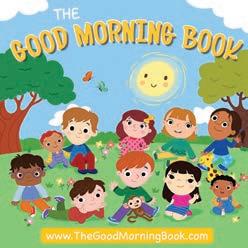
Mona’s Scrapbook Adventure IngramSpark
Come on an adventure with Mona as she helps her big sister, Layla, prepare for her wedding. This is a beautifully illustrated, fun and touching story about the bond between two sisters and their rich Algerian culture. Mona and Layla create lasting memories of their time together before their lives forever change. Readers young and old will enjoy learning Mona’s North African heritage, from the joyous sounds of ululation to the henna parties and the beautifully intricate dresses of Algeria. Plus, there are also extra pages in the back of the book to design your own scrapbook. Learn more at www.nouhasbooks.com

Cold Night, Long Dog
Ambidextrous Bloodhound Press
Smith dedicates his eighth book of poems to “my teachers, official and otherwise.” His opening poem, “Before,” is an admission of sorts about the difficulties of writing and accessing poetry during a time of pandemic isolation. Throughout the book, he also incorporates themes of music, particularly jazz, along with allusions to literary giants and meetings with friends. He has published poems in Poetry, The Paris Review and Salmagundi; stories in American Short Fiction and Big Fiction; and a memoir in Numero Cinq His book of poems, Little Black Train, won the 2019 Three Mile Harbor Press Prize. He has received fellowships from the John Simon Guggenheim and Ingram Merrill foundations. At Union since 1981, Smith teaches creative writing, contemporary American poetry and American literature.
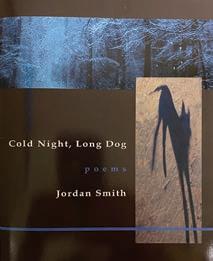
Media, formerly Bookshelf, features new titles by or about alumni and other members of the Union community. To be included, send a copy of the work (book, DVD, CD) and synopsis to:
Office of Communications Union College
Schenectady, NY 12308
Or send synopsis and high-resolution image to: magazine@union.edu
BARCOMB G’98 NOUHA DELIOU ’05 JORDAN SMITH, (Edward Everett Hale Jr. Professor of English)
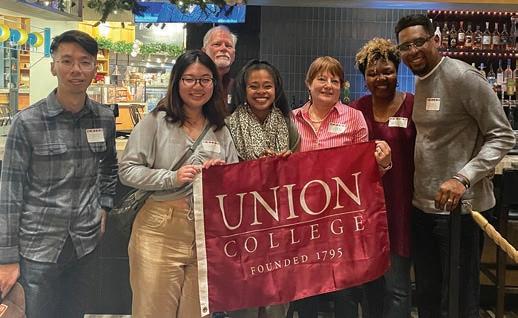


WASHINGTON, D.C.
INDIANAPOLIS
Alumni get together for happy hour in Indianapolis.
Each year the Office of Alumni and Parent Engagement receives numerous requests from across the country to assist alumni with events in their area. To better support your efforts, we created our own 1795 Event Box! We hope this box helps bring the Union spirit to all of your events.
NEW YORK CITY
Alumni enjoy an LGBTQ+ event in New York City.
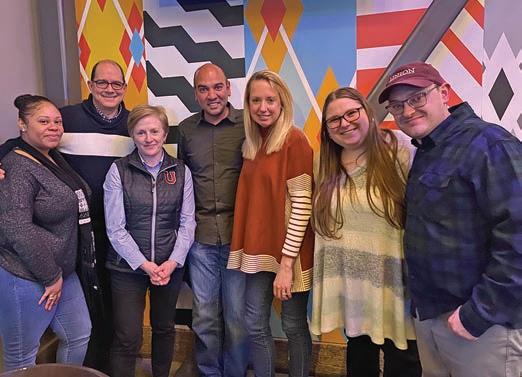


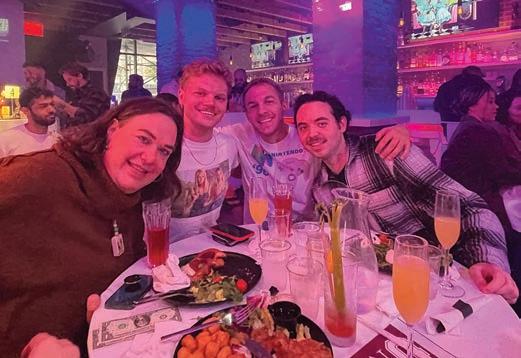
Event hosts will receive an additional Union hat until June 30, 2023. Our gift to you!

WHAT’S INCLUDED:
• 1 large banner (36" x 23")
• 10 small pennants
• 10 koozies
• 10 pens
• 10 balloons
NEW YORK CITY
TO ORDER VISIT ualumni.union. edu/1795box
Thomas Johnson ’62, Carolyn Johnson, Christopher Mahoney ’81, Dolly Mastrangelo and Cliff Mastrangelo ’63 attend the Washington, D.C. winter social. Alumni mentored students at a recent Union Financial Network event in New York City.
This past fall, the Alumni Council and the Office of Alumni & Parent Engagement organized and conducted a full slate of in-person events, meeting with alumni and parents throughout the country. We totaled 24 events this season, averaging almost two a week! We returned to some familiar locations, and visited new ones as well:
• New York City and Long Island, N.Y.
• North Andover and Boston, Mass.
• Fairfield, Conn./Westchester, N.Y. (Thanks to our new regional club!)
• Denver, Colo.
• Atlanta, Ga.
• Jacksonville, Fla.
• Austin, Dallas and Houston, Texas
We also hosted our first in-person event for our LGBTQ+ alumni in New York City. We were excited to see such strong attendance across all of these events. An important part of the Alumni Council’s mission is to connect with graduates here in the U.S. and abroad. We even have a dedicated committee for our Regional Clubs network that provides resources and helps organize great local events for alumni in their communities—wherever they are.
If you’d like to learn more about this network or events in your area, or if you’d like to help organize something for alumni, please visit us online (ualumni.union.edu). You can also contact Ashley Breslin, director of Alumni & Parent Engagement, at alumni@union.edu.
As always, we are excited to meet new alumni volunteers, and we encourage you to seek membership to the Alumni Council with an open call to applicants: ualumni.union.edu/acapplication.
In our next update, we look forward to sharing highlights from our civil engineering ReUnion (happening during ReUnion Weekend).
– Vin Mattone ’06 President, Union College Alumni Council
Involvement with Union since graduation: My experience with Union has been diverse. Class agent for several years with the Annual Fund, volunteer admissions representative at several college fairs in Maryland, Virginia, Washington, D.C., Illinois and Texas. But, most of my time was spent on the board of the Washington, D.C. Alumni Club.
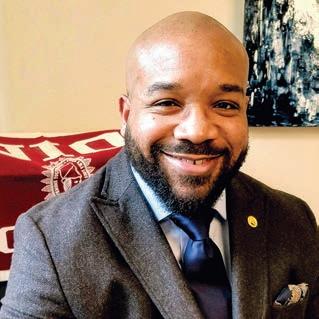
Favorite Union memory (as an alum or student):
Kyrie is as an internal investigator for the City of Dallas in the Office of Risk Management, working with police and fire rescue services. He has used his 18 years of investigative experience to develop his own consulting company to educate young police officers and the public on the purpose of policing. As a part-time adjunct instructor for the University North Texas System, he teaches criminal justice courses to aspiring criminal justice and law enforcement students. He is also a 2021 graduate of Texas Christian University, with a master’s in criminal justice and criminology. He majored in industrial economics and minored in Africana studies at Union.
During Kyrie’s tenure as a police officer in D.C., he participated in the annual Police Unity Tour in 2010. He cycled over 300 miles from East Orange, N.J., to the National Law Enforcement Memorial in D.C. to raise funds for the families of fallen officers. This event corresponds with the start of National Police Week.
Which of these activities has been most meaningful and why?
Volunteering for the D.C. Alumni Club has been the most rewarding. When you host an event and get the opportunity to meet alums that are dynamic and dedicated to their craft, and families, it becomes motivating. You get an understanding that you are not bound by your degree to only participate in that specific field; also, getting the opportunity to welcome recent grads from Union to the D.C. metro area and seeing their excitement as they begin the next phase of their lives.
What was your most formative experience at Union?
There were some issues that went on back in my home of Chicago that forced me to look myself in the mirror and decide it was time for me to become a young man. I decided it was best for my long-term future to stay away from my hometown. Nowadays we call that being aware of your mental health, but during the early 2000s, it was just about buckling down and finding a razor focus. My last two years at Union were spent on campus. I decided to take control of my life and it turned out to be the best decision at that time. I had a few alums and family members that I sought council from who provided much needed guidance those last two years. During this time, I focused solely on school, became heavily involved on campus and eventually became co-chair of the Senior Class Gift Committee.
My best friend, Dr. Kirk Campbell ’03, and I were sometimes called twins, based on the movie “Twins (1988),” starring Danny DeVito and Arnold Schwarzenegger. I was obviously Danny because I am short compared to Dr. Campbell. Anyway, we used it to our advantage and started dressing alike each year during the spring formal. We thought it was funny. Eventually other classmates started dressing alike during random events. As an alum, the D.C. Club planned an elaborate event hosted by Dr. Estelle Cooke-Sampson ’74, a Union trustee, in her lovely home. Several months later, it was recognized as Alumni Event of the Year for 2012. I was extremely proud to be a part of that moment, as I was chosen to receive the award.
Best advice you received:
At some point, you must take control of your life—whether you are 18, 28 or 38. None of us controls our upbringing, but we do have the ability to change our lives when we decide to do it.
Best advice you share with young people: Master the skills you do well while slowly building on the skills that need work. By the time people realize you do not know anything, your goal should have been accomplished.
Fun fact about yourself:
My son, August, was born during the pandemic and I became a stay-at-home father because it was the best decision for the family. For 14 months, I had the opportunity to raise my son and build a bond that will last me the rest of my lifetime. So far in my life, that has been the most fun and rewarding experience I have had.
Alumni Council memberUnion’s Parents Circle is a parent philanthropy group whose members become College insiders and investors in its success, ultimately developing stronger ties to their student’s Union experience. We invite all parents and families to join with us in supporting the educational programs and activities that will make your child’s Union experience extraordinary.
During my time as a student at Union, I discovered the wonderful sense of community that is part of the DNA of the school. Now, as a parent and member of the Parents Circle, I am able to experience that sense of community through a different lens. Our son started in the fall of 2020. Like so many other students across the country, he had to deal with the unprecedented experience of navigating through COVID-19. We have been so impressed with how President Harris and his staff led the school through those challenging times. Having the ability to provide feedback as a member of the Parents Circle made the connection to the school even more valuable. While we know that our time as parents of a student will end, we are excited to help enhance the experience at Union for current and future students.
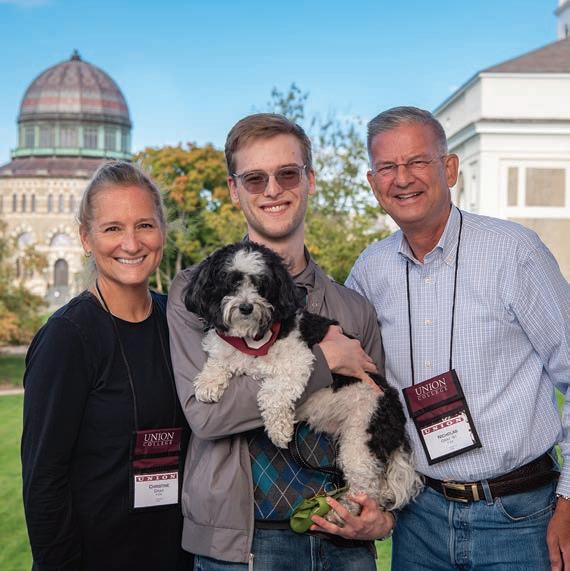 – Christine and Nick Gray ’81 P’24
– Christine and Nick Gray ’81 P’24
To learn more about the Parents Circle, please contact: Noelle Beach Marchaj '05, Director of Parent and Family Philanthropy Cell: 860-655-2875 | marchajn@union.edu union.edu/parents-families
Alumni who have celebrated their 50th ReUnion.
GARNET GUARD
CLASS CORRESPONDENT
John Honey ’61
121 Waterside Dr., Box 1175 North Falmouth, Mass. 02556 jahoney@msn.com
1944
CLASS CORRESPONDENT
Seymour Thickman thickm@icloud.com
Sy Thickman writes, “Have no idea of our present number but we certainly have had many experiences and it would be fun to share them with us and with Union. An incident that I enjoyed goes back to 1984. After active military involvement WWII and Korea, my wife and I decided to move to Sheridan, Wyo. In ’53, I started internal medicine practice there resulting in much professional pleasure and satisfying community involvement. In October 1984, I received a telephone call from President Ronald Reagan’s office indicating my appointment as local physician to Queen Elizabeth during her vacation period at the Wallop Canyon Ranch in Big Horn, Wyo. Senator Malcolm Wallop’s sister, Jean, was married to Lord Porchester who was the Queen’s major horse advisor. During the Queen’s visit, wife and I conferred with her, joined her
for dinner at Maverick’s supper club and she would handshake all the help in the restaurant before she left. The Queen was sincere, delightful and easy to converse with. This was a most memorable experience. I sent her a letter congratulating her on the platinum 70th year as Her Majesty, just before her death. Would appreciate notes from you during your years of experience. Our goals— enjoying life and staying well.”
Dr. Clifford Tepper was recently featured in a Daily Gazette article, “Celebrated Schenectady doctor turns 100.” Clifford ran a pediatric practice on Upper Union Street and taught at Albany Medical School. The office of Tepper, Tepper and Kennedy was a Schenectady institution from the 1950s to the 1990s.
Burk Ketcham writes, “Rowing, writing and painting are the activities that have busied me most during the 34 years since becoming a widower at age 63. Rowing was fun, kept me fit and took me to many foreign countries. Lots of new friends and many medals too. I quit at 91. Writing and self-publishing poetry, short stories and the Dyken Falls quadrilogy have been a satisfying challenge. I have just finished the fourth Dyken Falls
novel—“Off the Grid?” That’s my major accomplishment for 2022. I started to paint when I was about 73 and it’s an ongoing effort to become a better artist. I have joined the Schenectady Art Society and need to create new work for their exhibits. It has been my good fortune to have been able to lead an active and creative live as I have aged.”
1953
CLASS CORRESPONDENT
Hubert Plummer
21 Temple Road Setauket, N.Y. 11733 (631) 941-4076 whp@plummerlaw.com
1954
CLASS CORRESPONDENT
Avrom J. Gold
19702 Bella Loma, Apt. 9-102 San Antonio, Texas 78256 (908) 581-1455 avromgold@gmail.com
1955
CLASS CORRESPONDENT
Ken Haefner
1346 Waverly Pl. Schenectady, N.Y. 12308 kbhaefner@gmail.com
1956
CLASS CORRESPONDENT
William Deuell
2666 Steeple Run Lane Manteca, Calif. 95336 whd2923@gmail.com
Robert Scott writes, “I worked in aerospace for 20 years in missiles, space and weapon systems; became a real estate broker in 1974 and formed R.B. Scott Real Estate.”
1957
CLASS CORRESPONDENT
Paul Mohr
140 E Duce of Clubs Ste A Show Low, Ariz. 85901 dadtired@frontiernet.net
Anthony Ehrlich recently curated an exhibit of photographs of jazz icons at the Alice and William Jenkins Gallery at the Crealdé School of Art in Winter Park, Fla. The photos came from the collection of Ehrlich’s longtime friend, professional photographer Roger Kallins. It featured performance photos of 40 musical geniuses including Ella Fitzgerald, Ray Charles and John Coltrane. He writes, “My Ormond Beach friend Roger Kallins was, I thought, a good photographer. I didn’t realize how very good he was until after his death. When I saw the archive, I was blown away. Among the most striking of all his images were 60 years’ worth of pictures of great jazz musicians. To look at these photographs was to hear the music. As a photographer myself, I knew this work had to be shown.”
CLASS CORRESPONDENT
David C. Horton


68 Paul Revere Road Lexington, Mass. 02421 paulrevereroad@aol.com
Lydia Snyder writes, “My father, Spencer W. Potter, of Jamestown, R.I., who was a real estate broker and land conservationist, and served in the U.S. Army, died Sept. 15, 2022. He brokered significant real estate transactions across Massachusetts, especially on Martha’s Vineyard, and in Rhode Island. As a passionate conservationist and board member of the Conanicut Island Land Trust for 20 years, much of his real estate work furthered the conservation of undeveloped land. He was an active, eclectic person, passionate about his family and friends, and quick to share a joke. He was a sailor of traditional boats, an early windsurfer, a polo player and draft horseman. He was a household inventor and adept woodcarver. Having a multigenerational family history of Union alumni, he once won a prize for the most alumni relatives. They include Alonzo Potter, Class of 1818; Edward Tuckerman Potter, Class of 1853; Union President Eliphalet Nott; as well as his father, John H.N. Potter, Class of 1919; brother, Clarkson Nott
Potter, Class of 1950; and brother-in-law Oscar R. Kruesi, Class of 1945. He was 86. Survivors include his granddaughter, Sophia Potter ’20, nephew Jack Howard-Potter ’97, brother-in-law Stephen Ferber ’70 and cousin Ned Lincoln ’08.” Spencer is also remembered on p. 69 of the In Memoriam section.
1959
CLASS CORRESPONDENT
William “Dal” Trader 5361 Santa Catalina Avenue Garden Grove, Calif. 92845 daltrader@earthlink.net (310) 629-8971
1960
CLASS CORRESPONDENTS
Charles E. Roden kiw702@aol.com
Joel Kupersmith, M.D. jk1688@georgetown.edu
J. Dixon Bergman writes, “It took a while, but I finally became a full-time artist in 2019 after working as a one-man advertising agency for too many years. My Union mechanical engineering background helped me mesh

with my industrial clients and now enhances my thinking as my artwork moves off the canvas onto 3D wall hanging sculptures.”
Kirk Bent writes, “My research partner, Dennis Caplan, and I have an article in the January/ February 2022 issue of the CPA Journal titled ‘An Introduction to Lattice Allocations.’ It is about a method that I invented for doing complex reciprocal cost allocation, usually considered too complex to do correctly. Mercifully, despite being based on somewhat advanced math, the method is very simple to apply. I have put the method in the public domain, available to all. I’ve also done Excel and Python implementations, again available to all.”
CLASS CORRESPONDENT
John Honey jahoney@msn.com
Dr. Gary L. Gross of Boston received the “Lifetime Health Access Champion” award at the ABCD Community Heroes Celebration Nov. 18. He was
honored for his courageous and effective leadership of programs that enable individuals of all economic means to have access to family planning and highquality health care. He retired March 31, 2022, as medical director of ABCD Family Planning Services, after serving in that position since 1981. Learn more about Gary and his career at abcdheroes.org/ drgarygross
Paul Jacobs writes, “A good friend and former boat partner, Tom McDonald, his wife Sheila, Nancy and I recently purchased a 1964 Graves Constellation sailboat with the intention of ultimately restoring her to her former glory. We initially located her in Stony Point, N.Y., and Tom and I ultimately sailed her down the Hudson. Under the Tappan Zee bridge, under the George Washington Bridge, around the battery. Under the Brooklyn, Manhattan, Williamsburg, Queensboro, Robert Kennedy, Hells Gate RR bridge, Bronx—Whitestone and Throg’s Neck bridges, into Long Island Sound, along the Connecticut shoreline, past Westerly, R.I., around Point Judith, up Narragansett Bay, under the Jamestown-Verrazano bridge and eventually to her current home in Wickford,
R.I. Quite the adventure for a couple of old salts. We will likely spend the next 12–18 months restoring her, which will surely be rather exhausting, but a labor of love. When we are finally done, she will a true classic, built when we were all very much younger.”
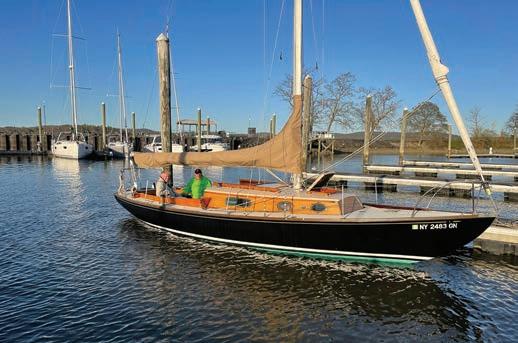
1965
Classmates are remembering Vic Fazio, who passed away March 16, 2022, as a student leader who went on to a political career as a partisan member of Congress with a reputation for working across the aisle. He served as a Democratic member of the House of Representatives for California from 1979 to 1999. A member of the appropriations committee, he was also chair of the subcommittee on the legislative branch. He chaired the Democratic Caucus, the third highest position in the party. After Congress, Fazio worked as a lobbyist for clients in telecommunications, retail and medicine. As a Union student, the history major was president of Student Council,
class president, and a member of the lacrosse team and Chi Psi fraternity. He won the Daggett Prize for outstanding conduct and character. He was the chancellor at Union’s commencement in 1998, when he told graduates, “No challenge, however complex, is beyond the ability of the American people if we confront it honestly, debate it frankly, and work together to find and apply a solution.” Two California landmarks honor his legacy: the Vic Fazio Yolo Wildlife Area, a 16,000-acre reserve north of Sacramento, and the Vic Fazio Highway (Route 113) north of Davis, Calif.
1966
CLASS CORRESPONDENT
Antonio F. Vianna
7152 Tanager Drive Carlsbad, Calif. 92011
simpatico1@juno.com
1967
CLASS CORRESPONDENT
Joseph Smaldino
6310 Lantern Ridge Lane Knoxville, Tenn. 37921
smaldinoj@comcast.net
(815) 762-5984
Michael Fuchs is included in a new book by reporters Felix Gillette and John Koblin, It’s Not TV: The Spectacular Rise, Revolution, and Future of HBO. As a review in The Washington Post states, “The character whose work at HBO propels the first chapters of the book is its onetime chief executive Michael Fuchs, an entertainment lawyer turned development exec, whom Gillette and Koblin paint as a stylish, Robert Evans-esque daredevil…”
Jeffrey Hedquist writes, “The Iowa High School Speech Association chose me to deliver the keynote address and a workshop, Hot Tips for Audio Storytelling—Radio, Commercials, Podcasts, Audio Theatre, to 300 amazing competition coaches at their 50th Anniversary Coaches Convention. It was a great day of helping them to ‘Light the Way’ for their students.”
Jeffrey, as “Advertising’s Storyteller,” has spoken to hundreds of advertising, marketing and broadcast associations as well as
universities across the country. Learn more at http://www. hedquist.com/seminars
Jeffrey Hedquist has also narrated Bruce Lipton’s audiobook, The Biology of Belief 10th Anniversary Edition: Unleashing the Power of Consciousness, Matter & Miracles, available on Amazon and Audible. He writes, “I always learn something. Just like a single cell, the character of our lives is determined not by our genes but by our responses to the environmental signals that propel life. The more awareness an organism has of its environment, the better its chances for survival.” Jeffrey has voiced 27 versions of Chicken Soup for the Soul, as well as audiobooks for Deepak Chopra, John Douillard and others. Learn more at http://www. voiceover-voices.com/

1968
CLASS CORRESPONDENT
John Dresser
Etna, N.H.
jdressernh@gmail.com

1969
CLASS CORRESPONDENTS
George Cushing Delanson, N.Y. pinyachta@gmail.com
Ray Pike Salisbury, Mass. rnwpike@comcast.net
1970
CLASS CORRESPONDENT
Frank P. Donnini Newport News, Va. fpdonnini@aol.com
Mark Kopins writes, “I have been taking euphonium/ baritone lessons once per week since I retired. That’s 19 ½ years of lessons! I think playing an instrument keeps one’s brain active. I played in a community band for a number of years, but now I play pretty much to entertain myself.”

1971
CLASS CORRESPONDENT
Henry Fein, M.D. Rockville, Md. hgfein@aol.com
1972
CLASS CORRESPONDENT
Fred Levy glida1@icloud.com

1973
CLASS CORRESPONDENT
Larry Swartz Niskayuna, N.Y. larry.swartz@agriculture.ny.gov
Patrick Guida was recently elected president of the American College of Commercial Finance Lawyers. Patrick is a frequent speaker on commercial finance topics at national forums. He has been providing legal services to institutional banking clients throughout New England for more than three decades and previously served as in-house counsel for two major banks.
1974
CLASS CORREPSONDENT
Cathy Stuckey Johnson San Mateo, Calif. caj1080@hotmail.com
Bill Westheimer writes, “In 1970, 10 young guys found themselves at Union, living in West College third floor for their freshman year. We became great friends and have stayed in touch ever since. In September 2022, those same 10 guys (and spouses) got together for a long weekend reunion in Warrensburg, N.Y. The farthest traveler was Will Waters from Quito Ecuador. Others included Rich and Cindy Siegel from Chatauqua, N.Y.; Ken and Denise Boise from Sherburne, N.Y.; Joe and Kathy Leitgeb from Schenectady; Len Baglia and Tricia Barrett from Athens, N.Y.; Peter Keller and Deborah Billings from the D.C. area; Bill and Lisa Westheimer from West Orange, N.J.; Rolf and Jane Wandel from the Boston area; Reid Russell from Raleigh, N.C.; and Dave Druschel from Canandaigua, N.Y. We are the same devoted friends and have not changed in the 52 years. Well, for some of us our hair is thinner and grayer. Our memories of Union are strong as ever. We try to get together every year. This was one of the largest groups. A great time was had by all and we started planning for next year as the group dispersed on Monday.”
In September, some members of the Class of 1974 got together in Warrensburg, N.Y. In attendance were Will Waters, Rich Siegel, Ken Boise, Joe Leitgeb, Peter Keller, Bill Westheimer, Rolf Wandel, Reid Russell, Len Baglia and Dave Druschel.


Norm Thompson writes, “I retired seven years ago from my career as a software engineer. Have been living in Colorado for the past 35 years or so. Love the outdoor lifestyle here in the mountain west. My wife and I have travelled to many countries around the world to pursue two activities: scuba diving and caving. I am an avid cave photographer, an activity that combines two interests that I first got involved with while a student at Union. Some of you may remember my super-8 movie about the boy who falls in love with a bomb. Art Bragg ’76 was the star of that movie and I still keep in touch with him—he lives just a few miles away from me here in the Boulder area. I got started with caving at Union mostly with Thom Engel ’76. My cave photography has appeared in many publications, videos, websites, etc. I’d be happy to communicate via email with classmates, and I can share links to some of my cave photography, talk about my engineering career, or whatever. Please share a bit about your lives via email or here in the Union College magazine!”
David Wagner retired from his position as associate professor of mathematics at the University of Houston. He and his wife, Jeanette, have moved to Berkeley, CA, to live with their daughter Katie and her family. They really enjoy the Berkeley weather!
Andrea Barrett was recently featured in The New York Review of Books in an article titled “Uncommon Women.”
Gary Maas, an attorney with Barclay Damon, was recently named to the 2023 edition of
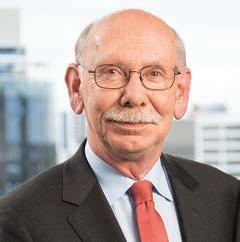
The Best Lawyers in America
He specializes in corporate law in the firm’s Buffalo office.
1976
CLASS CORRESPONDENT
Paul Boyd pboyd@yahoo.com
Bill and Sue Martin were expecting their 18th grandchild in January. Bill recently retired after almost 40 years practicing family medicine, and he’s busier and happier than ever!

Russell Torrisi writes, “Retired Oct. 2020. Now enjoying career of coaching youth hockey while I can still get on the ice.”
Craig Diamond has continued to fail at retirement and has been appointed to the Sierra Club’s Conservation Policy Committee and as lead volunteer on its Land, Water & Wildlife Campaign.
Naomi Robbins, Dotsie Whitney, Cathy Cummins Rimsky, Susan Parnes Sankin, Alan Schifman, Andy Messinger (husband of Karen Sokoloff ), Lee Rimsky, Ken Sankin (husband of Susan), Mark Gross ’75, Steve Seif (husband of Dotsie), Ellen Witt Reiss, Peter Reiss ’73, Ronna Feldman Coppola and Sam Coppola ’74 recently attended Eric Messinger’s wedding in Cartagena, Colombia. Eric is the son of Karen Sokoloff, who
writes, “We were thrilled that our wonderful Union friends made the trip to South America to celebrate with us.”
CLASS CORRESPONDENT
Leila Shames Maude LeeShamesMaude@alumni. union.edu
CLASS CORRESPONDENT
Jeff Laniewski, Florence, Ariz. jlaniewski4@gmail.com
Andrew Vesey was recently appointed to the board of directors at Nikola Corporation, a global leader in zero-emissions transportation and energy infrastructure solutions. He is president and CEO North America at Fortescue Future Industries.
Don Dulchinos recently participated in a weeklong Kappa Alpha brothers’ cycling adventure. Read more in Ted Borer’s entry for the Class of 1984.
1979
CLASS CORRESPONDENT
Kurt Hamblet
San Luis Obispo, Calif. kurthamblet@gmail.com
1980
David Marker writes, “In 2019 I retired from the University of Illinois at Chicago, where I was a Liberal Arts and Sciences Distinguished Professor in the Department of Mathematics, Statistics, and Computer Science. After 37 years, I am now leaving Chicago and relocating to New York City.”
Gregg Singer, Peter Raymond and Russ Davidson recently participated in a weeklong Kappa Alpha brothers’ cycling adventure. Read more in Ted Borer’s entry for the Class of 1984.
Rich Templeton has been elected vice chair of the board of directors of the Semiconductor Industry Association. Templeton is chair, president and CEO of Texas Instruments Inc.
1981
CLASS CORRESPONDENT
Sue Barnhart Ferris sferris59@gmail.com
Steve Buchanan recently participated in a weeklong Kappa Alpha brothers’ cycling adventure. Read more in Ted Borer’s entry for the Class of 1984.
Dr. Nancy Gagliano was recently named an advisor at Workflow Services, a comprehensive and automated platform that solves point-ofcare clinical service delivery for pharmacies.
Cory Lewkowicz Needham, Mass. corylewkowicz@gmail.com
Carla Cogan writes, “I’m excited to share that I recently joined Glaser Weil as the chief business development and marketing officer. In my new role, I’ll work closely with the firm’s senior leadership to lead strategic growth for the firm.”
1984
CLASS CORRESPONDENT
Linda Gutin
Durham, N.C.
lindagutin@hotmail.com
Liss Gruen writes, “In January of 2020, during the height of the pandemic and when I was seeing patients in one of the two dedicated COVID-19 buildings in the state of Colorado, I was conferred the degree of fellow of the American Academy of Family Physicians. With no in-person events going on back then, it took more than two years before I was finally invited to participate in a national convocation ceremony in Washington, D.C., on 9/23/22. This means I get to add extra letters to the end of my name!
I’m now Melissa Beth Gruen, MD, JD, FAAFP, FCLM. On the personal side, I’m still playing hockey and so is my 11th grade daughter. She and my husband and I continue living in Denver and are looking forward to another great ski season. Here I am with one of my hockey teams (I’m in the center, with the “C” on my jersey). And yes, my favorite color is still orange!”

Sheila Acker Spitz and Adam Spitz write, “It was our 35th
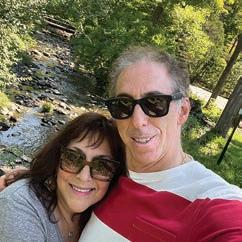
wedding anniversary this September and the 41st anniversary of dating at Union. So on our way for Adam to ride his bike in his 15th JDRF ride for a cure to diabetes, which was held in Saratoga that weekend, we had to stop on campus, empty our wallets at the school store and grab a final sandwich at the soon-toclose Slicks. Jackson’s Garden was especially beautiful and romantic that weekend.”
graduate of Babson College and an active volunteer for several charitable organizations in Boston; passionate about making a difference for others; and is a third-generation ballroom dancer in our family, a dream come true for me personally. I was recently recognized as Forbes America’s Top Women Wealth Advisors 2021 and Forbes America’s Top Women Wealth Advisors Best-in-State 2022.”
Alissa M. Quinn writes, “I am delighted to share that my daughter, Rachel Quinn, is the newest member of the Quinn Wealth Management Group at UBS Financial Services. Rachel had a very successful tenure as director, sales and marketing at prior firm. She is a
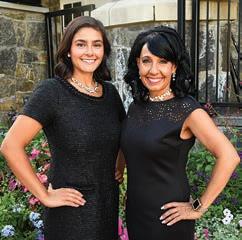
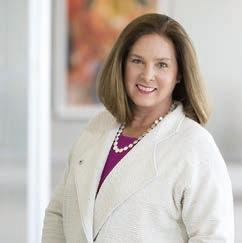
Edward “Ted” Borer writes, “Several of us from Kappa Alpha enjoyed a weeklong cycling adventure around Eastern New York State early this fall. We cruised through the Electric City and enjoyed an evening with undergraduate members of KA, too. In
Members of Kappa Alpha stopped at Union during a weeklong cycling adventure this fall. They are Peter Raymond ’80, Steve Buchanan ’81, Russell Davidson ’80, Gregg Singer ’80, Edward “Ted” Borer ’84 and Donald Dulchinos ’78
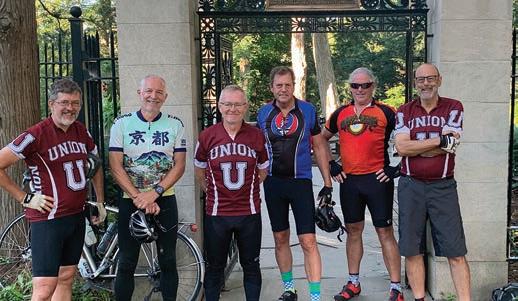
Vickie Chandler Silver ’87 writes, “A ReUnion of ladies from the ‘80s happened over Veterans Day weekend in Saratoga Springs, N.Y. Loved being together!” Alumnae in attendance included Sue Serenska Herrmann ’85, Sarah Andrews White ’85, Trisha Allen Kozub ’85, Gabe Salvagna Bartlett ’85, Vickie Chandler Silver ’87, Tricia Bowering Stegemann ’85, Tricia Pasqualini Agosta ’86 and Nancy Baum Lipsitz Langer ’85.

addition to savoring beautiful scenery, we logged hundreds of miles of horizontal riding, a day of rain, a few dirt roads, and a few miles of vertical elevation gain. It was all about catching up, camaraderie, storytelling (seriously, the statute of limitations passed a long time ago!), music, stargazing, philosophy, good food, comfortable lodging. And maybe a few new shenanigans along the way!” In addition to Ted, those participating in the adventure included Peter Raymond ’80, Steve Buchanan ’81, Russell Davidson ’80, Gregg Singer ’80 and Donald Dulchinos ’78.
1985
CLASS CORRESPONDENT
Timothy Hesler
timothy.t.hesler@gmail.com
Dr. Jay Baruch appeared on the podcast “Clear & Vivid with Alan Alda” in October. Titled “Jay Baruch: In the ER, your story matters,” the episode is available at https://clear-vividwith-alan-alda.simplecast. com/episodes/jay-baruch-inthe-er-your-story-matters.
1989
CLASS CORRESPONDENT
Jay is a professor of emergency medicine at Alpert Medical School of Brown University, where he serves as the director of the Medical Humanities and Bioethics Scholarly Concentration.
1987
CLASS CORRESPONDENT
Drena Root drena.kr@gmail.com
1988
Jonathan Artz, MD writes, “I am finishing a one-year program in corporate innovation at the Stanford Graduate School of Business. I founded an Innovation in Health Care Community on the Expert/Mentor Sharing Platform called WEAVR. Through this Health Care Innovation Community, I reconnected with Dr. Robert Uzzo (CEO of the Fox Chase Cancer Center), who was in my Union class, but was part of the Union-Albany Med 6-year medical program. Any Union alumni who have a strong passion for innovation in the health care arena— biomedical engineers, industry representatives in innovation/ information technology or MBA(s) with specialty in the health care area—please connect with me on LinkedIn.”
Tanya N. Helfand has joined Schenck Price Smith & King as a partner with her entire team from family law firm Helfand & Associates. Tanya will chair Schenck Price’s family law and divorce practice group. With 28 years of legal experience, Tanya is a certified matrimonial attorney and a graduate of Pace University Elisabeth Haub School of Law.
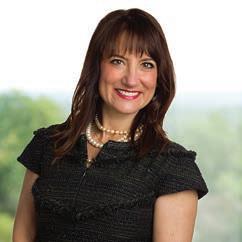
Jen Brandwein
jenbrandwein2@gmail.com
Elizabeth Dobbs Hoenscheid owns Top It Off, an accessory company that makes the Dawn Glove, which was featured on the 2022 Oprah’s Favorite Things holiday gifts list. Learn more about Top it Off at topitoffaccessories.com.
Andrew Conway, professor and department head in the Department of Psychology in the College of Arts and Sciences, joined New Mexico State University in July.
Conway’s research is aimed at understanding individual differences in cognitive ability and how those differences matter in life, with respect to academic achievement, job performance, income and health.
CLASS CORRESPONDENT
Laurel Mullen
jay.mullen@comcast.net
Union alums enjoy a day on the seas. Pictured are Captain Andy Albert ’89 P’26 with wife Lauren; Bob Koch ’88 and Laura Koch ’89 P’25; and Eric Miller ’91 P’22 and wife Susan
Paul Garnett had brunch with Michael Andelman ’94 at Fresco in Needham, MA. Mike is a regular and lives nearby. Paul lives in Savannah. Paul had the salmon eggs benedict (light on the benedict sauce) and chamomile tea, and Mike had two eggs with bacon and an English muffin (Mike’s wife is English) and a cup of coffee. Paul had one refill of herbal tea and Mike had one-and-ahalf refills of coffee. Paul and Mike talked about their time at Union, their respective wife and kids, and their minor professional successes. Paul and Mike said it was great to see each other and agreed to stay in touch. They forgot to take a selfie.
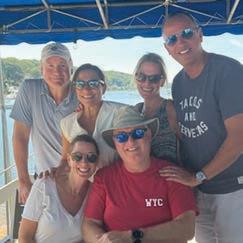
Fiona Shukri ’89 has lived a life across borders, oceans and cultures. A life happily spent fostering international development, government outreach and civil society engagement. From Washington, D.C. to Paris to Kabul. From Azerbaijan to Egypt to Palestine, Jordan and Iraq.
Now a senior advisor and independent consultant for non-profit and private contractors, Shukri previously worked for the National Democratic Institute for International Affairs and the United Nations Educational Scientific & Cultural Organization. She has also been a journalist, her writing appearing in outlets like the Los Angeles Times, The Christian Science Monitor, The Daily Beast and PassBlue. She still provides occasional analysis and news stories to select publications.
Breaking down exactly what her job entails, Shukri explained that she works on U.S. or U.K. government-funded programs to foster democratic structures and practices.
“This is in countries emerging from war or moving away from authoritarian rule,” she said. “I work alongside other international development professionals from around the world with expertise in government, agriculture, banking, human rights and so on.”
“I focus on improving national government outreach to the media and the public,” added Shukri, who holds an M.A. from NYU in Middle East studies and journalism. “Hopefully by doing that, it creates more government transparency.”
She also encourages government officials to cooperate more with outside experts—academics, activists, nongovernmental experts.
“This can be for public dialogue and feedback or it can be more formal, such as to include non-government actors in development of national policies,” said
Shukri, who studied English at Union. “This is the civil society engagement part.”
Shukri recently moved to Bangkok to work on USAID health, humanitarian and human rights programming in neighboring Myanmar. This past winter, she was in Baghdad on a U.K. government-funded project to improve a federal commission’s public information and media practices.
“Years ago, I’d have thought this sounded terribly boring. But I find it fascinating. I get to learn about Iraq’s politics and work in my area of expertise,” Shukri said. “Also, the commission is designed to combat corruption, so being transparent and responsive to the public is really important.”
It’s a big job with lots of challenges, but also its share of big rewards.
“Recently, I was evacuated from a government building in Baghdad because of nearby Katyusha rocket attacks. That’s the dramatic answer to what’s challenging,” she explained. “And working with
people from different cultures, in different political structures, is both rewarding and challenging. So that’s the snappy answer to what’s rewarding.”
But the highs and lows go well beyond the very real threats of danger and meeting new people from varied backgrounds.
“The most personal challenge is being of practical service to my host-country colleagues while fulfilling the demands of these big government programs. Government funders want ‘I trained X number of people on X topics,’” she said. “But my Afghan colleagues, for instance, risked their lives trying to improve the Afghan government. How can checking a box on my contract be enough? It’s hard to meet the demands of the government contract and be of use to your counterparts. Sometimes it’s double duty.”
“The best personal rewards come from supporting host-country colleagues. I met an Afghan woman in Kabul who had run

“FOLKS WHO SPEND A LONG TIME IN AFGHANISTAN (THERE AREN’T MANY OF US BECAUSE IT’S A TOUGH GIG) AGREE THAT THE COUNTRY SEEPS INTO YOUR BONES. IT’S A HAUNTING, POETIC, SINGULAR PLACE. IT’S NOT MY FAVORITE PLACE TO LIVE, BUT IT’S AFFECTED ME MORE THAN ANYWHERE ELSE. I SEE MYSELF AND THE WORLD DIFFERENTLY BECAUSE OF MY TIME THERE.”

an underground women’s rights group during Taliban rule in the 1990s,” Shukri continued. “I can’t articulate the courage that took. It’s very humbling to be at a table with someone like that, let alone work with her. Those are the moments I remember.”
Shukri spent a decade living in Afghanistan between 2008 and 2018, during which time one of her jobs was advising the Ministry of Interior—the country’s police and national security ministry.
“It was very dangerous, but advising the media team felt important. That experience made recent history even more painful,” she said. “There was no good strategy for international troop withdrawal, but the way the U.S. left was
devastating. I spent that August crying, and trying to assist Afghan friends and colleagues terrified for their lives. Some of them got out. Some are still trying.”
Indeed, Afghanistan left an indelible mark on Shukri, whose sister, Buthaina Shukri, is a member of the Class of 1981.
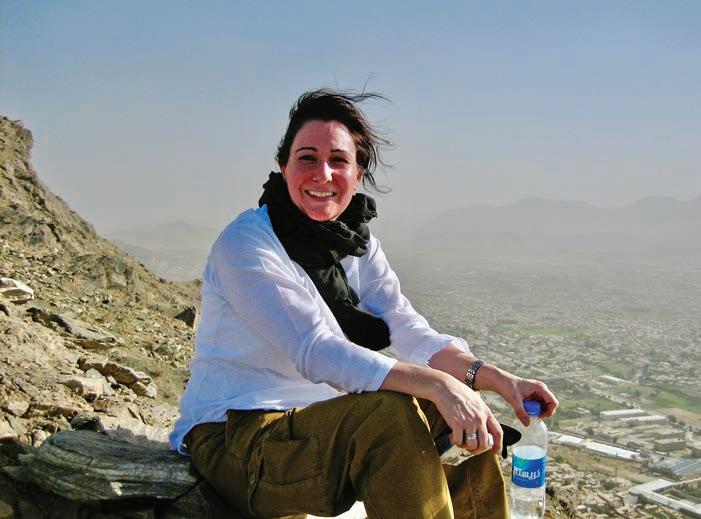
“Folks who spend a long time in Afghanistan (there aren’t many of us because it’s a tough gig) agree that the country seeps into your bones,” she said.
“It’s a haunting, poetic, singular place. It’s not my favorite place to live, but it’s affected me more than anywhere else. I see myself and the world differently because of my time there.”
While a long way from Kabul, Schenectady is also memorable for her.
“Union influenced my career entirely. Serving as co-editor-in-chief (with Christine Hong ’89) of Concordiensis revealed my professional passion and strengths,” Shukri said. “I worked harder on Concordiensis than I’d ever worked on anything, and loved every minute of it.”
The initial impactful experience of the paper, though, came before she was even a writer, let alone an editor.
“Dave Gulliver ’88 and I were dragged to Rupsi's Tavern by our respective roommates on their first date,” Shukri remembered. “I said to him, ‘You’re an editor for the school paper? You should make me write. I need something to put on my resume.’”
“He did and the rest is history. My career and lifelong friendship with Dave were launched from those barstools. Concordiensis served us both well, actually. Dave made a successful career as a journalist.”
Erica Frank writes, “I joined the Concierge Medicine Department at the Massachusetts General Hospital a year ago and I have never been happier. I finally have the time I need to take care of my patients!”
Brendan Clifford writes, “My oldest son, Connor, has applied to Union College and is hoping to matriculate next fall. We have our fingers crossed. My youngest son, Dylan, is ramping up on his own college search. There are some exciting times. I wish the best to all of my friends and classmates from the Class of 1992.”
Melissa (Isenstein) Kagan writes, “I had the unbelievable opportunity to be the Hadassah Boston Community Leader for a group of 11 women/moms on an amazing Momentum trip to Israel. It was thrilling to be traveling again and to be learning and connecting with so many amazing women. On the family front: my older daughter began her freshman year at University of Delaware (early childhood education major with a specialization in special education), and my younger daughter is busy applying to colleges as she wraps up her senior year in high school. Next up is to plan a trip this summer for my husband and me to celebrate our 25th wedding anniversary!”
David Burg writes, “With the kids out of the house—three in college and one graduate working in NYC government— my wife and I are focused on enjoying this next phase of life. In the community, I help lead my congregation as board chair. In business (PIRHL.com), I still develop, build and/or rehab affordable, multifamily properties in the Midwest and Mid-Atlantic. I recently reconnected with our former
classmate, Mary Wein Robbins, a fellow Clevelander and businesswoman.”
CLASS CORRESPONDENT
Jill D. Bernstein New York, N.Y. jilldbernstein@yahoo.com
Nate Fitch writes, “While playing at a box lacrosse tournament in Toronto, we stopped at the Hockey Hall of Fame, where we saw the Union puck in the hall!”
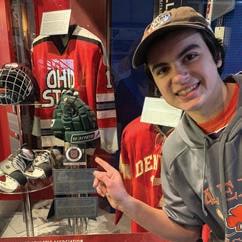
1994
CLASS CORRESPONDENT
Randall Beach Schenectady, N.Y. rsbeach72@gmail.com
Kate Grady is president of rebars & mesh, an independent WBE/DBE-certified reinforcing steel fabricator. In 2021, she was featured in CM&B’s Women in Construction Week (cmbteam.com/women-inconstruction-week-2021rebars-and-mesh/)
1996
CLASS CORRESPONDENT
Daimee Stadler-Isralowitz daistu@optonline.net

Restaurateurs—and their employees— have suffered a lot during the COVID pandemic. There’s really no other way to say it.
Few understand this better than Melissa Fleischut ’90. As CEO of the New York State Restaurant Association (NYSRA), she’s been at the forefront of helping restaurants survive and adapt.
“Leading NYSRA during the pandemic has been stressful, emotional and exhausting,” said Fleischut, who has been CEO since 2013. “Listening to the struggles of restaurant owners as they tried to keep their doors open, their staff employed and their families fed has been truly heartbreaking.”
The association, whose membership includes several thousand New York restaurants, protects the hospitality industry through advocacy, supporting businesses with events and education, and providing key training and cost-saving programs. The goal, Fleischut said, is to make a restaurant owner’s job easier, and
make their business the best it can be.
To carry out this mission during the pandemic, NYSRA began holding weekly calls for members and non-members. Association staff provided updates on the latest rules and restrictions, and best practices on what was working. A nightly email was also launched, compiling everything NYSRA staff learned into one message so that members would not have to comb through multiple sources of information.
“Lastly, we told their story to anyone who would listen,” Fleischut said.
This included working with the National Restaurant Association on federal programs, like the Payroll Protection Program, Economic Injury Disaster Loans, Employee Retention Tax Credit and the Restaurant Revitalization Fund.
“We did hundreds of press interviews and met with state legislators and government officials on any issue that needed to be addressed,” she added. “We proposed— and succeeded in getting—outdoor dining
open even earlier than indoor dining, and we constantly advocated for restrictions to be eased or lifted.”
The popularity and success of outdoor dining offered some salvation and was one of the biggest wins for restaurants early in the pandemic. Another was alcohol to-go.
“Allowing alcohol to-go through most of the pandemic, and now as we try to rebuild, was a lifeline for many small bars and restaurants,” Fleischut said.
Yet challenges persist, even three years into the pandemic.
“Inflation has increased the cost of food, goods, services, labor, energy and rent,” Fleischut explained. “While some of the costs can be passed along in higher prices to customers, restaurants know that if they raise prices too much, their guests will dine elsewhere or simply stay home.”
To help, NYSRA is working hard to find every dollar for its members—from split case fees and delivery fees to credit card swipe fees. It’s offering a manufacturers
rebate program for its members as well.
“We’ve also launched new benefits during the pandemic to help our members retain their employees,” Fleischut said. “We now offer more mental health resources, 24-hour access to health care providers, and we are launching a new 401K program for our members.”
With these programs, and the nature of restaurant owners themselves, she is hopeful about the future.
“New York restaurant owners and employees are some of the most creative anywhere. They constantly adapted their businesses to keep going no matter the obstacles,” Fleischut said. “I was also impressed by the generosity of some of our members, who created brand new programs to feed frontline workers in hospitals, restaurant employees and food-insecure residents in their own neighborhoods.”
Fleischut has worked with NYSRA most of her career, having started out in the National Restaurant Association as an intern—a job she credits to a Union professor.
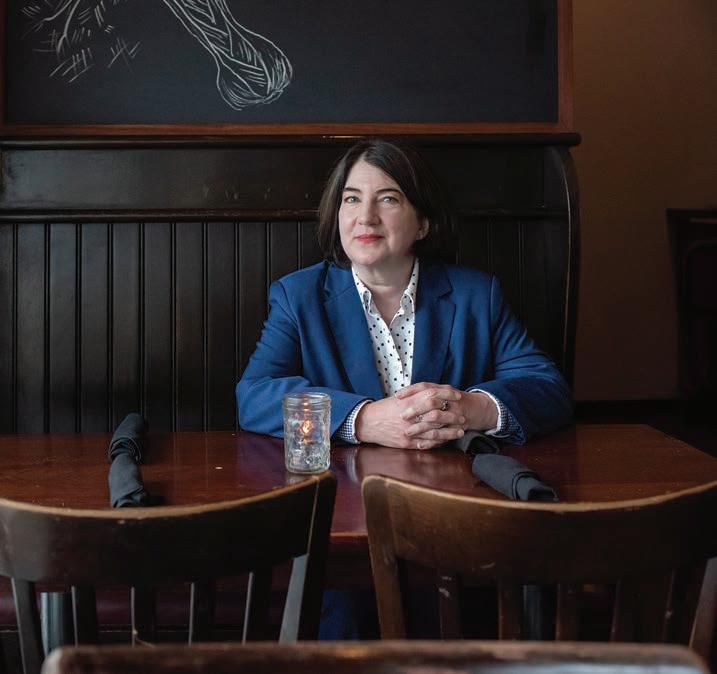
“After receiving my master’s degree from George Washington University in international affairs, I had a good academic resume but no real-world experience,” she recalled. “Professor [Charles] Gati recommended I take an internship to gain the experience I needed.”
“I listened and took an internship in the government affairs department of the National Restaurant Association.”
This led to a full-time job in state relations, which a few years later, led to a job in New York.
“LISTENING TO THE STRUGGLES OF RESTAURANT OWNERS AS THEY TRIED TO KEEP THEIR DOORS OPEN, THEIR STAFF EMPLOYED AND THEIR FAMILIES FED HAS BEEN TRULY HEARTBREAKING.”
1997
CLASS CORRESPONDENT
Sara Amann Garrand Ballston Lake, N.Y. sgarrand1@nycap.rr.com
David Moresi has been elected to a three-year term on Berkshire Health Systems’ board of trustees. In 2000, he established the firm of Moresi & Associates, a diverse real estate management, investment and development company in North Adams, Mass., that has redeveloped the Norad Mill.
1998
CLASS CORRESPONDENT
Ryan T. Smith Jupiter, Fla. ryan.smith@thebenjamin school.org
1999
CLASS CORRESPONDENT
Kellie Forrestall BeeBee Lowell, Mass. forrestkj@hotmail.com
2001
CLASS CORRESPONDENT
Erin Grogan erinlgrogan@gmail.com
2002
CLASS CORRESPONDENT
Elise DiBenedetto elise.dibenedetto@gmail.com
2003
CLASS CORRESPONDENT
Katrina Tentor Lallier Shrewsbury, Mass. katrinalallier@gmail.com
2004
CLASS CORRESPONDENT
Jon Berman jonathancberman@gmail.com
Sarah Pontius, a Union College trustee, was recently featured

in “Architectural Digest.” The story focused on her new company, Artisan, a hybrid brokerage and design firm.
Pete Sally was recently featured in the Boston Globe in the article, “Local venture fund aims to diversify health tech industry.” The story focused on Seae Ventures, of which Sally is a founder.
2005
CLASS CORRESPONDENT
Annette C. Stock annettecstock@gmail.com
Annette C. Stock writes, “I’m midway through graduate school at University of Virginia Darden School of Business, getting my MBA. It’s a blast! I’m rep for my section (go section B!), received a mid-program leadership award that means a lot to me and I’ll be graduating in the spring. Lots of Teach for America alumni folks are also in the program so it feels like a great fit for me and I’m really happy. If you are in the DMV area, especially Charlottesville, I would always love to connect with folks!”
CLASS CORRESPONDENT
Sarah T. Heitner New York, N.Y. sarah.t.heitner@gmail.com
Mike Pieciak was recently elected Vermont state treasurer. Previously, he was commissioner of Vermont’s Department of Financial Regulation.
Brianne Baggetta was recently featured in the Times Union newspaper’s “20 Things” segment. She is president and CEO of the Mailworks, a direct-mailer company.
2007
CLASS CORRESPONDENT
Jackie Siedlecki Murphy jaclynrenemurphy@gmail.com
2008
CLASS CORRESPONDENT
Dana Cohen Bernstein New York, N.Y. dana.lynn.bernstein@gmail.com
Carla Reeves has joined the Board of Directors of YouthBuild USA, the global nonprofit that champions opportunity youth—young adults between the ages of 16 and 24 who are neither in school nor employed—as they earn the knowledge, training and opportunities that lead to long-term professional and personal success. This appointment creates a majorityfemale board leadership—a first in its history—and advances the organization’s commitment to its mission by better reflecting the diverse population it serves. Carla is a director at Goulston & Storrs, where her practice is focused on advising companies and organizations on employment matters; representing clients in state and federal litigation, administrative proceedings, and arbitration proceedings; and conducting investigations of discrimination, harassment, retaliation and other forms of workplace misconduct.
Jamie Dughi Hogenkamp, an attorney with Barclay Damon, was recently named to the 2022 Upstate New York Super Lawyers Rising Stars list. She specializes in health care at the firm’s Albany office.
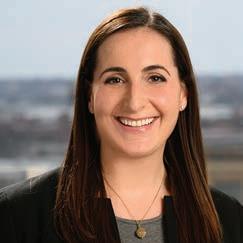
2009
CLASS CORRESPONDENTS
Gabe Kramer Los Angeles, Calif. kramerg3@gmail.com
Carl S. Winkler New York, N.Y. carl.s.winkler@gmail.com
2010
CLASS CORRESPONDENT
Deanna Cox deannac88@gmail.com
Dolev Melamed writes, “I left New Orleans and moved back to Israel January of 2019, then moved back to the Boston area this past June. I’m working as the vice president for a company called CalleoHealth. I’m also planning my wedding and hope to have a photo to share at the end of next summer!”
2012
CLASS CORRESPONDENTS
Anna Meiring annameiring@gmail.com
Benjamin Engle benjamin.engle@gmail.com
Union College is many things to many people. To Charles Sumpter ’07, it’s a place of self-discovery. And a place where his life’s work began.
“I came out at Union and learned more about myself than ever before. My experience at Union helped me learn how to embrace my own difference while expanding my appreciation for the vast differences of others,” he explained. “I was elected freshman class president in 2003 and served on Student Forum for most of my time at Union. This gave me a unique perch to assess matters of equality and inclusion campus wide. I saw that much more work was needed.”
He didn’t see many people who looked like him, for instance, either on the faculty or in his classes. This inspired Sumpter and a friend, Niya Brooks ’07, to think about what they could do to change things.
“Together, we created Union’s first-ever Black Student Union (BSU) organization to help foster a more inclusive environment for Black students, allies and other students of color,” he said. “Our effort to promote inclusivity at Union through BSU was greatly inspired by the work of the late professor Twitty J. Styles
through his organization, UNITAS, and other supportive allies like professors Deidre Hill Butler and Erica Bell.”
Today, Sumpter is senior director of diversity, equity and inclusion for the World Wildlife Fund (WWF). He joined WWF this past year and previously worked in government at both local and federal levels. He also held positions at private firms like Booz Allen Hamilton and Deloitte. In both fields, he helped his employers think more strategically about transforming their operations to “attract and retain a more diverse workforce.”
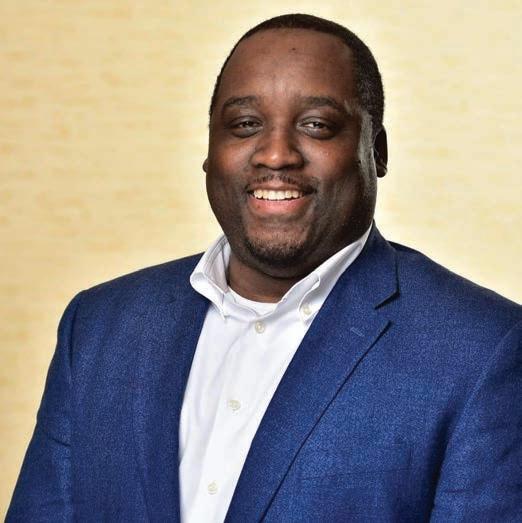
Sumpter is looking forward to seeing what he can do in the non-governmental organization. His responsibilities with WWF include overall development and implementation of strategies and initiatives that advance diversity, equity and inclusion (DEI) internally, while also making WWF an employer of choice for diverse populations. Sumpter’s team helps foster a workplace culture in which employees feel safe, respected and included as well.
“I thought WWF would be a unique, but suitable challenge for me to combine my experiences in the public and private
sectors to make a lasting impact at one of the world’s leading environmental conservation groups,” Sumpter said. “Additionally, environmental conservation is a space that has traditionally not attracted a lot of BIPOC talent (Black, Indigenous and people of color). I want to change that.”
“I often say that we do not have a planet B, so we are all in this together. Many of the effects we now see from climate change are directly impacting BIPOC communities across the country and even globally,” he continued. “The task ahead for all of us is incredibly daunting, but I am hopeful that through inclusive solutions and engagement we can tackle those challenges more effectively with diverse groups of folks around the table.”
When he’s not working, Sumpter, who majored in political science and East Asian studies at Union, enjoys cooking and spending time with his husband, Jordan, and their English bulldog, Bo. He serves on the LGBTQ+ task force for his home city of Alexandria, Va. In 2016, he helped found Safe Space NOVA, which supports LGBTQ+ youth in northern Virginia.
A life & career dedicated to diversity, equity & inclusion
2013
CLASS CORRESPONDENT
Cristina Vazzana Boston, Mass. vazzanaca@gmail.com
Lindsay Gerrato ’21, Emily Zangrillo and Ran Wang ’15 participated in Union’s annual Women in Economics event Nov. 8. Each spoke about how they used their economics degree since graduating, as well as their current position and how they got there. Emily is a senior analyst, family office advisory at ICONIQ Capital in New York City. Ran is a product pricing advisor at Dell Technologies in Austin, Texas. Lindsay is an investment analyst at Prudential Private Capital in New York City.
2016
CLASS CORRESPONDENT
Lauren Woods Watervliet, N.Y. 2016@alumni.union.edu
2017
CLASS CORRESPONDENT
Jake Ulrich jake.ulrich@duke.edu
Jake Ulrich successfully defended his doctoral dissertation in civil and environmental engineering at Duke University in August 2022. After receiving his Ph.D., Jake was awarded an ORISE Postdoctoral Fellowship to conduct research at the FDA in the Center for Food Safety and Applied Nutrition. He looks forward toward his new position and catching up with Union friends in the DMV area!
Katlyn Oliver writes, “I recently got engaged to Curtis White ’18. We got engaged in March 2022 on Good Harbor Beach
in Gloucester, Mass. We will get married in Beverly next year (May 2023). Curtis’s family has been a part of Union for many years, his father is the crew coach and some of his siblings went through Union as well (Emma White ’19, Sarah White ’21 and Harrison White ’24). My maid of honor is Mary Claire ’17 and bridesmaid is Lindsay Degnan ’17
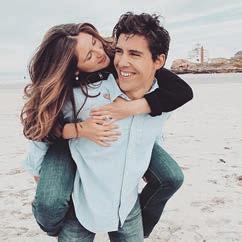
2018
Matthew Lewis and Talitha Kumaresan ’19 got engaged to be married August 6, 2022, in Jackson’s Garden at Union College. They were fortunate to do so where they first met (Union College) and with their families present.
Curtis White won the men’s elite national cyclocross title Dec. 11 in Hartford, Conn. Curtis, who has placed second at the event the last three years, overtook defending champ Eric Brunner on the final lap.
2019
Gilian “GiGi” Singer, sexuality educator and founder of the GiGi Spot, returned to campus in October. She shared her expertise and knowledge with the Union community in two sessions: “Sex Positivity—
Learning how all faculty and staff play a role in supporting our students’ sexual health, relationships and identity;” and “How to be Good in Bed and Good at Life—Learn how to incorporate your values and life skills into a healthy sexual experience.”
2020
CLASS CORRESPONDENTS
Kayla Fisher kaylafisherny3@gmail.com
Omarra Hannibal-Williams ohannibalwilliams@gmail.com
Meaghan Barros started medical school in summer 2022.
Ian Krause was recently featured in a Times Union story, “Krause’s Homemade Candy passes on to fourth generation.” Ian took over the Saugerties, N.Y., business following the retirement of his uncle.
2022
Tess Gallagher was recently featured in ArsTechnica. The story focused on her discovery of Diplodocus skin—extraordinary by itself—and her subsequent revelation (aided by a microscope) that its scales were porous.
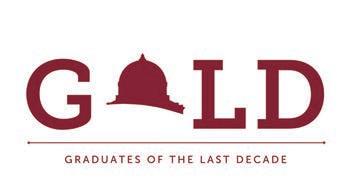
Young alumni are busy leaving their mark on the world and still bring their time and talent back to Union. Check out how these Graduates of the Last Decade (GOLD) have stayed connected to campus:
opportunity to have their questions answered.
Were there alumni who visited your classes and encouraged you to try something new? Was there a scholarship you received that supported your Union experience?
The Graduates of the Last Decade (GOLD) Network is made up of recent graduates (2013-2022). Think of GOLD as the next step in your Union journey; a way for you to stay connected to Union in ways that are most meaningful to you. Your support and engagement will drive the success of future generations of students— whether that’s attending an event, making a donation or chatting with a student.

Gillian Russo and Michael Giurlando celebrated their wedding in Sarasota, Fla., at Marie Selby Botanical Gardens May 15, 2021, following their elopement in New York City Nov. 14, 2020. Alumni in attendance included Lindsay (Colvin) Stone, Jamie Schellens, Katrina (Neiley) Schellens, Chuck Pappas ’11, Lauren McCartney, Claire (Chazen) Sandler, Jessica Sherrod ’12 and Briana Cincotta.
James Padgett and Gina Pantore were married May 13, 2022, with ceremony and reception on site at the Bronx Zoo among friends and family. James, an electrical engineer, works as a project engineer on high-voltage transmission and renewable energy projects. Gina is a client media director, managing a team of media buyers. They live in Westchester County and traveled to Australia for their honeymoon in the fall. In attendance were Robert Davis, Colton Lewis, Ashley Resetarits, Sean Hartnett, Jackie Milano (nee Salzillo), Rachel Finkelstein, Thomas DeFina, Alex Lieberman-Cribbin and Chandler Taylor.
Kayla Lawrence and Geoffrey Noah were married Sept. 4, 2022. Alumni in attendance included Emma Zipursky, Dylan Larabee ’12, Aaron Elkin, Peter Elkin ’78, Perianne Smith ’20, Suhasini Chico ’14 and Kevin Chico ’14.


Kelsey Fish and Mickey Allan were married July 23, 2022, in North Adams, MA. In attendance were Nick Vozzella, Jake Soodek, Emma Stein, Jesse Grushack, Evan Morris, Dr. Caroline Gorka, Nicole Collins, Kara Modliszewski ’15, Melissa (Scinto) D’Annibale, Julia Shively ’15, Jenna (Cornwall) Novak ’15, Max Novak ’15, Gabrielle (Biederman) Kitchen, Teddy Kitchen, Emily (Crandall) Bradlee, Joe Bradlee, Samantha Muratori, Noah Futterman, Brendan Dahlgren, Kyle McCue and Dr. Dylan Martini.
Steve Melia and Brooke Stoller were married August 20, 2022, at Chatham Bars Inn in Chatham, Mass. Alumni in attendance included Danielle Melia ’16, Kayleigh Melia ’12, Greg Mooney, Jake Quinn, Pat DeBenedetto, David Wood, Brady Collins, Nate Greenberg, Matty Friedman, Rob Santangelo, Mike Miceli, Ty Roselli,
Jeff Law, Dylan Tripodi, Kyle Mcquiggan, Joe Bradlee, Emily Bradlee, Carson Mehl, Courtney Collier, Haley Brown, Megan Murphy, Leah Doucette, Carolyn Connors ’17, Kyle Christine ’13, Megan Kerbs ’16, Shea Barickman ’16, Janine Cerutti ’16, Connor Hall ’15, Brad Woodruff ’15, Alex D’Amario ’15, Will Mahony ’12 and Bobby Sullivan ’12.
Ellie MacGregor and Jimmy Mulpeter were married Oct. 1, 2022 in Wellfleet, Mass. Alumni in attendance included Sara and Andrew Rouff, Nell Pinkston, Nancy Pace, Kelsey Carroll, Ryan Kenna, Ryan Atkins, Chris Pignatello, Chris Kelly, Matt Perillo ’16, Lauren Coryea, Pat Mulpeter ’14,
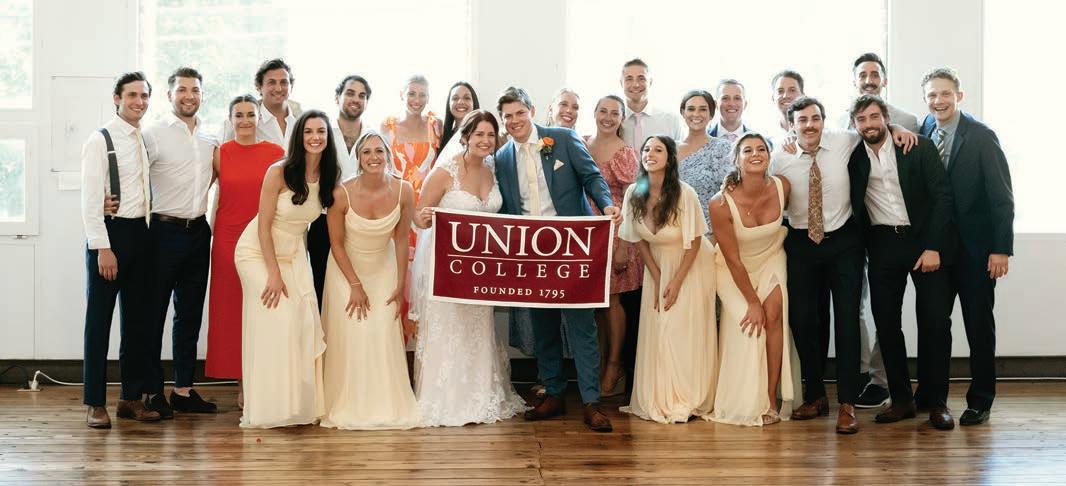
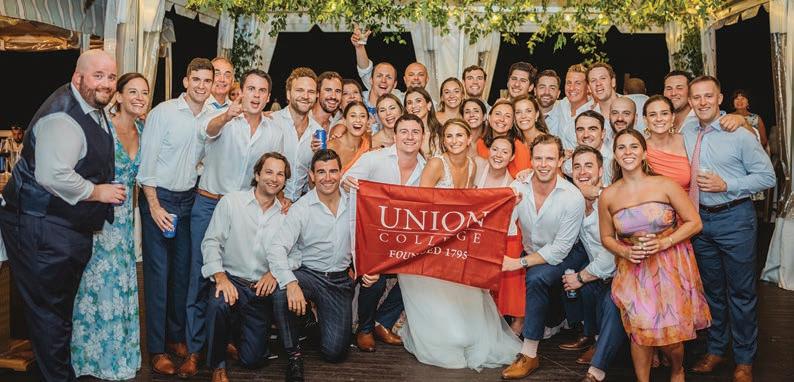
Josh Wasserman ’17, John Bonventre ’79, Michael Mulpeter ’80, Paul Stobolf ’80, Steve Wasserman ’80, Carl Seiden ’80, Ali Czech ’91 and Eric Czech ’92.
Matt Rametta married Leanna Ippoliti Oct. 1, 2022, in Woodland Park, N.J. Alumni in
attendance included Lucy Miller ’16, Stephen Boyd ’16, Kenny Marshall ’16, Sang Won Choi, Ben Schwartz, Ben Mountain, Justin Itzkowitz, James Hawkins, Zack Hersh, Dan Meandro, Dan Tompkins, Brian Cattafe, Brendan
O’Connor, Will Tomolonis, Zach Roth, Tim Woods ’18, Chris Marina ’18, Taina Orellana ’18 and Taylor Finn ’18.
Lauren (Gibson) Fontaine and Andrew Fontaine were married recently in Cohasset, Mass.


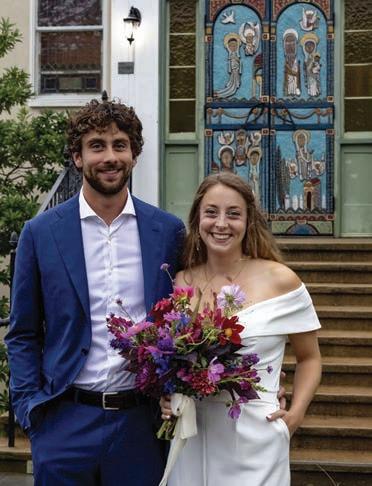
Alumni in attendance included Ben Wilkinson ’15, Kelley (White) Wilkinson ’16, Lauren (Woods) Lipeles ’16, Alyssa Bonesteel, Katherine (Moeller)
Tesoriero, Allison Vandoren, Amanda Price, Brendan
Cheevers, Marc Mazza, Joe
Noonan, Will Tomalonis, Robbie Barsamian, Nathaniel
Altman, Jeremy Manus, Ian Bennett, Brianne Hallock ’18, Helena Roland 1’8, Matthew
Ferdenzi ’18, Rachel Riley ’18, Alaina Thaxter ’19, Connor
Horan ’19 and Jason Miller ’19.
Margaret Furman and husband Seth Leventhal ’95 welcomed their son, William Robert Leventhal, March 8, 2022.

Casey and Tom DiLaura welcomed Luke Corbett DiLaura Sept. 26, 2022. His big brother, Cole, couldn’t be happier.
Courtney (Foster) Miller and Rush Miller welcomed Calliope Eloise Miller on May 10, 2022 in New York City.

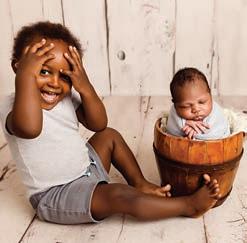
Sam Ringel and Molly Head ’11 welcomed their daughter, Eloise Laci Ringel, Dec. 1, 2021.


Conor O’Reilly and Samantha (Zayas) O’Reilly welcomed James Oliver O’Reilly Aug. 23, 2022, in Los Gatos, California. Conor, Sam and big sister Emily are overjoyed!
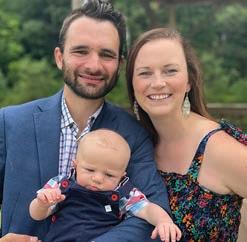

Deanna Cox writes, “We recently expanded our family to include our newest addition (another baby boy) on August 1. Our first son, Keyo Seely, turned 2 years old on December 21, and our second son, Ryu Seely, turned 4 months old on December 1. Also, we recently relocated from south Florida to the Boston area, as I was offered a position (associate director of college counseling) and now work at Phillips Academy Andover.”
Monica (Niedermeyer) Lareau writes, “Jon and I had our second girl Aug. 18, 2022, Margot Iris Lareau!”
2016
Stephanie (Dick) Storie and Steven (Stangle) Storie ’14 are thrilled to have welcomed their first daughter, Annabelle Robyn Storie, May 13, 2022.
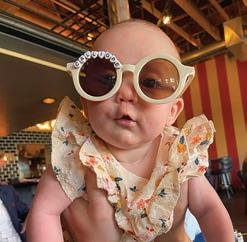
2017
Alli (Devins) Ammirato ’17 and husband Roman Ammirato welcomed their baby, Baylor, on April 25, 2022.
Robert E. Edwards ’44, of Lexington, Mass., who served in the U.S. Navy during World War II and spent 43 years with Raytheon, Oct. 26, 2022. His major achievements included working on the Hawk and Patriot missiles and development of the microwave oven for home use. A volunteer with the Collings Foundation, he co-wrote Raytheon Company: The First Sixty Years Dr. Gerald Bongard ’48, who was the classical music program manager at WRUC during his time at Union, Oct. 22, 2022. He was 97.
Victor F. Mattson ’49, of Brunswick, Maine, who served in the U.S. Army during World War II and received a Purple Heart for the Battle of Herrlisheim, Oct. 20, 2022. He held a doctorate from the Institute of Paper Chemistry and spent his career in the paper industry, and managed and built a state-of-the-art pulp mill in Mississippi. He was 97.
Robert B. Keane ’50, of Indianapolis, Ind., who served in the U.S. Navy and Navy Reserve, Aug. 6, 2022. A newspaper reporter, magazine writer and editor, he later went into public relations with several companies, including the Hartford Insurance Group. He was 97.
Leon M. Bundy ’51, of Naples, Fla., who served in the U.S. Navy and worked for Western Electric before joining IBM, Sept. 11, 2022. Jack, as he was known, loved skiing and golfing, and owned Vineyard Christian Bookstore in Naples until 2001. He was 96.
William H. Cleary ’51, of Montgomery, Ohio, who served with the U.S. Air Force during the Korean War and graduated from Siena College, Sept. 13, 2022. He held an MBA in management from Xavier and retired after many years with Procter and Gamble. William was 92.
Dr. Irwin Friedman ’51, of Amherst, N.Y., Oct. 22, 2022.
Dominick F. Carbone ’55, of Ocala, Fla., who held a master’s degree from Columbia and served in the U.S. Navy, Sept. 15, 2022. He worked at New York Telephone and retired as treasurer before becoming vice president of finance and planning at Sarah Lawrence College. He was 89.
Rex D. Sawyer ’57, of Napa, Calif., who was a captain and pilot in the U.S. Air Force for 10 years, Oct. 5, 2022. He later spent 30 years in the stock and bond trade, retiring from Paine Webber. Rex, who loved tennis, traveling and his Kona condo, was 87.
Spencer W. Potter ’58, of Jamestown, R.I., who served with the U.S. Army and was a real estate broker and land conservationist, Sept. 15, 2022. Spencer brokered significant real estate transactions across Massachusetts, especially on Martha’s Vineyard, and in Rhode Island. A board member of the Conanicut Island Land Trust for 20 years, he was 86.
Carlo Evangelisti ’58, of Scrub Oak, N.Y., who served in the U.S. Air Force in Japan and held an M.S. in electrical engineering from Syracuse University, Oct. 25, 2022. He spent his career in research with IBM at the Thomas J. Watson Research Center, and co-authored over 100 U.S. patents, trademarks and papers.
Dr. Michael J. Epstein ’59, of Houston, Texas, who graduated from the State University of New York Downstate Medical School, Aug. 14, 2022. He formed a private
practice in hand surgery and served two years as senior vice president and chief of staff at St. Luke’s Hospital. A Navy and Naval Reserves veteran, he was 84.
Dr. Franklin Fiedelholtz ’59, of Miami, Fla., who specialized in cardiology for more than 50 years, mostly in South Florida, Sept. 3, 2022. A graduate of Upstate Medical University, he also did a fellowship at Emory University. He was 85.
Darrell W. Harp ’60, of Scotia, N.Y., who graduated from Albany Law School and was admitted to the New York State Bar, Sept. 27, 2022. An expert in transportation and construction law, he was general counsel and assistant commissioner of legal affairs for the New York State Department of Transportation. He was 84.
Peter B. Favata ’61, of Holden, Mass., who was an insurance adjuster for more than six decades, Aug. 6, 2022. A Red Sox fan, loved his family, fishing, word games and Dunkin Donuts. He was 83.
John Leslie ’62, of Albany, N.Y., who held a graduate degree in engineering from Union College, Oct. 25, 2022. Jack worked with Union Carbide in West Virginia and General Electric in Schenectady, and went on to found his own consulting firms. He was 82.
Stanley J. Harris ’64, of Schenectady, N.Y., who taught middle school health and science for 20 years, Aug. 22, 2022. Always proud to have received his BA and master’s from Union, Stan was dedicated to community work and “paying it forward,” for the time when he knew he would need helping hands. Stan, who battled Parkinson’s Disease for more than 20 years, was 79.
Samuel G. H. Turner II ’64, of Sarasota, Fla., who graduated from the University of Rochester, Aug. 20, 2022. He went into the insurance business and became a partner at Amsden-Connor-Mitchell. Sam, who loved vintage cars, was active in his community with organizations like United Way. He was 80.
Dr. Stanley N. Brand ’65, of Prairie Village, Kan., who graduated from Jefferson Medical School and worked at Statland Clinic in GI and internal medicine, Oct. 3, 2022. He served on numerous boards and with several religious organizations, and was grants chairman for the Reach Foundation. He was 77.
Dr. David G. Belanger ’66, of Hillsborough, N.J., Nov. 18, 2022.
Marcel G. Tardif G’67, of North Smithfield, R.I., who graduated from St. Michael’s College and held a master’s degree from Union College, Sept. 5, 2022. He was a teacher at the former Sacred Heart Academy, Central Falls, Mt. St. Charles Academy, Woonsocket and Bellingham High School. A former trustee of St. Agatha’s Church, he was 87.
Emanuel B. LaMacchia ’67, of Syracuse, N.Y., who spent 34 years as a math teacher at Lyncourt School, Aug. 30, 2022. Manny attended the University of Rochester and loved being outdoors while hunting, fishing or enjoying his gardens and cottage at Lake of the Isles. He was 76.
Rosemary Miner G’68, of New Bern, N.C., who graduated from the New York State University at Plattsburgh before earning a master’s degree from Union College in American studies, Nov. 22, 2022. A public school teacher for 34 years, she also authored a biography of a Confederate officer and a historical mystery series. She was 94.
Dr. John Hine ’68 died Oct. 19, 2022.
Allan C. Shartrand G’69, of Glenville, N.Y., who held a B.S. from Clarkson University and a M.S. in mechanical engineering from Union College, Nov. 17, 2022. An engineer for G.E. from 1954 to 1992, he held seven U.S. patents and authored numerous IEEE papers. He was 90.
Alan Kohn ’71, of Brookhaven, Miss., who was a freelance bookkeeper and movie producer, July 15, 2022. He was 73.
Dr. Lawrence S. Schek ’71, of Clinton Corners, N.Y., who was a founding physician at The Heart Center and served as president of medical staff at Vassar Brothers Medical Center, June 4, 2022. Also chief medical officer at St. Vincent’s Hospital (Bridgeport, Conn.) and Putnam Hospital Center (Carmel, N.Y.), he enjoyed photography, golf and travel.
Donald H. Diamond G’71, of Sarasota, Fla., who graduated from Worcester Polytechnic Institute and held an M.S. from Union College in industrial administration, Oct. 15, 2022. He spent two years in the U.S. Army and later joined IBM in Poughkeepsie, holding numerous technical and management positions and retiring after 36 years. He was 82.
Robert B. Billmyre Jr. ’71, of Middletown, Del., who retired from the Army Corps of Engineers after more than 40 years, Oct. 26, 2022. Bob, who enjoyed spending time with his family, analyzing stats for his fantasy football team, watching a good movie or enjoying a bowl of popcorn, was 72.
Peter J. Keller ’72, of Williamsville, N.Y., and Davidson, N.C., who spent 50 years at Keller Technology Corporation, Aug. 8, 2022. Executive vice president of the company and an avid runner and musician, he was 72.
Charles G. S. Blake ’72, of Albion, N.Y., who was an avid reader and loved country music, Sept. 8, 2022. He was a bank manager before beginning a 20-year career as a supervisory loan officer at the Small Business Association in the Office of Disaster Assistance. He was 73.
James H. Thornley G’72, of Wappingers Falls, N.Y., who was an Army and Korean War veteran and math teacher in Harrisburg, Pennsylvania, Oct. 14, 2022. He later spent 28 years with IMB in Poughkeepsie. A graduate of Elizabethtown College who held an M.S. in industrial administration from Union College, he was 89.
Dr. Susan L. Rattner ’74, of Media, Pa., a member of Union’s first class of women, who went on to complete her training in internal medicine at Columbia-Presbyterian Hospital, Dec. 22, 2022. An award-winning teacher and administrator, she rose to vice president for academic affairs at Jefferson Medical College (now Sidney Kimmel Medical College). She was 70.
Maston B. Sansom G’74, of Ballston Lake, N.Y., who graduated from The Ohio State University and held a master’s in mechanical engineering from Union College, Aug. 11, 2022. Matt spent 50 years with Knolls Atomic Power Laboratory in the Naval Nuclear Laboratory and Naval Reactors Program. He was 74.
John Van Zweden G’75, of Ormond Beach, Fla., who graduated from Newark College of Engineering and held a master’s in engineering from Union College, July 28, 2022. He enjoyed a long career with the New York State Department of Transportation. He was 78.
Thomas Karis ’76, of Gilroy, Calif., who held many degrees from Union College, RPI and Carnegie Mellon University, including two doctorates, Oct. 10, 2022. Tom held many patents and worked for many years in Silicon Valley, starting with IBM. In retirement, he ran his own consulting company in the field of tribology. He was 68.
William A. Collins ’77, of Wilmington, Del., an Eagle Scout who was an engineer with E.I. DuPont early in his career, Nov. 21, 2022. Most recently, he was vice president in technology project execution at J.P. Morgan Chase. He was 67.
Franklin B. Gilbert Jr. G’78, of Denver, Colo., who graduated from Northeastern University and held a master’s degree in industrial administration from Union College, Oct. 10, 2022. He worked for GE in Pittsfield with the Naval Ordnance Division. A member of First United Methodist Church (Pittsfield), he was 91.
Priscilla M. H. Herzog ’79, of Atascadero, Calif., who earned a law degree from the University of New Hampshire Franklin Pierce School of Law, Oct. 3, 2022. First a public defender with Orange County, she later practiced in the Santa Barbara County Public Defenders office. She was 66.
Edward L. Scholl ’80, of Avondale Estates, Ga., who held a master’s and Ph.D. in political science from Emory University, Aug. 10, 2022. He had a 30-year career at the U.S. Court of Appeals in Atlanta. He was 64.
Robert K. Tarmey ’80, of The Villages, Fla., who held an MBA from Russell Sage College, Oct. 16, 2022. He worked for 43 years supporting the Naval Nuclear Program in Schenectady, was a pilot with a local flying club and enjoyed sailing on local rivers. He was 72.
Russell Atkins ’85, of Coxsackie, N.Y., Oct. 6, 2022.
Emilios C. Kyriakides G’86, of Queensbury, N.Y., who was an administrator of radiation oncology at Albany Medical College, Oct. 27, 2022. Emilios, who held a master’s degree in health administration from Union College, was 86.
Susan M. Newell G’88, of Amsterdam, N.Y., who held a bachelor’s degree from the College of St. Rose and an MBA in accounting from Union College, Oct. 3, 2022. She enjoyed a long career with the State of New York, Price Chopper and Golub Corporation. Susan, who loved her son, beagles, cooking and Italian cuisine, was 68.
Kerry L. Couchman G’88, of Pittsfield, Mass., who held a B.S. from SUNY Albany and a master’s degree in computer science from Union College, Nov. 21, 2022. An engineer at General Dynamics, he was 64.
Mark C. Dostie G’93, of Hinsdale, Mass., who graduated from MCLA and held a master’s degree from Union College, Oct. 22, 2022. He was employed as a software engineer with General Dynamics for more than 35 years. Mark, who enjoyed fishing and camping with his family, was 55.
Eric Salazar ’96, of Fort Lauderdale, Fla., who enjoyed spending time with family and was passionate about research and learning new things, listening to music and being a sports aficionado, June 24, 2022. A devout Catholic who loved attending his daughter’s swim meets, he was 47.
Mary E. Hannon, of Saratoga Springs, N.Y., who was a home economics teacher and later a librarian at Union College and the Town of Ballston Community Library, Aug. 21, 2022. A graduate of Russell Sage College, she was 100.
Carolyn J. Micklas, of Schenectady, N.Y., who was employed by Planned Parenthood, Ellis Hospital and Union College, Sept. 1, 2022. Active in her community, she served on the Schenectady City School Board, among other commitments. She was 83.
Pauline F. Muth, of West Charlton, N.Y., who spent 30 years as a science teacher at Scotia-Glenville Junior High School and was a world-renowned bonsai teacher, Sept. 24, 2022. A past president of the American Bonsai Society and winner of its lifetime achievement award, she was 76.
Stanley J. Kaminsky ’75, a former professor of philosophy known for his creative, witty and enthusiastic teaching, passed away Nov. 2. He was 69.
He taught at Union from 1980 to 1991 in courses ranging from the history of philosophy to logic to biomedical ethics.
Robert Baker, the William D. Williams Professor of Philosophy Emeritus, recalled his former colleague’s great intellect and innovative teaching style. “Those of us who had the pleasure of teaching him or working with him recognized him as a brilliant and witty philosopher and an exceptionally popular
teacher who filled his classes with puzzles and poems,” Baker said. “He found a variety of ways to bring logic and epistemology to life. His colleagues recall his good humor, kindness, wit and affability.”
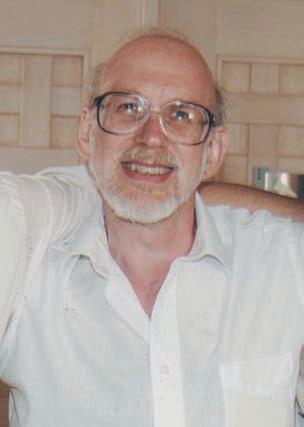
A 1982 teaching evaluation by Jan Ludwig, then department chair, noted that Kaminsky “prepares meticulously for his classes; indeed he more than prepares, he rehearses. A familiar sight in the Humanities faculty lounge is Kaminsky pacing back and forth, notes in hand, going over the class in which he is about to appear.”
Playful by nature, Kaminsky is shown juggling in a group photo of philosophy faculty in the 1984
Freshman Record. He frequently held classes outdoors.
After Union, Kaminsky joined the technology sector at Fleet Bank and other firms as an analyst and programmer.
An Albany native, he was valedictorian of his class at Albany High School. He earned a B.A. in philosophy from Union in 1975, graduating summa cum laude as class salutatorian. He went on to earn his master’s and Ph. D. from the University of Michigan.
He was a member of Temple Israel and a dedicated volunteer at the Daughters of Sarah Community.
Your support helps us create new opportunities for Union. And the recently-signed Consolidated Appropriations Act creates a new opportunity that can benefit you and Union!
You can now make a distribution from your IRA to create a life income gift, such as a charitable gift annuity (CGA), charitable remainder unitrust or annuity trust. This new type of Qualified Charitable Distribution is a one-time maximum transfer of $50,000 to a qualified CRT, or in exchange with Union for a CGA. Important terms and conditions apply so we encourage you to contact our office or your financial advisor.
Thank
Circle Society
CGAs have always been mutually beneficial, and increasing rates combined with this new gift option are just another incentive to support Union—all while helping yourself. FOR
To request a personalized illustration or for more information, contact:
